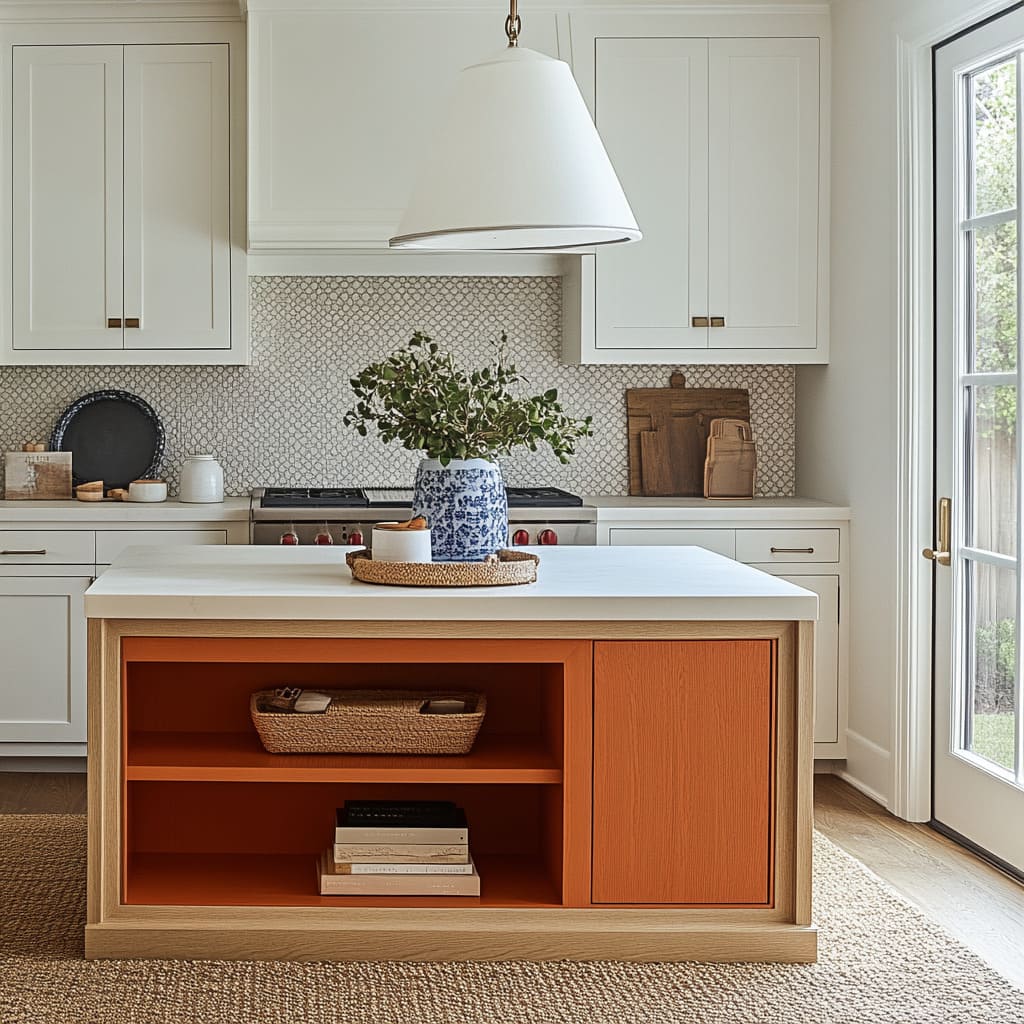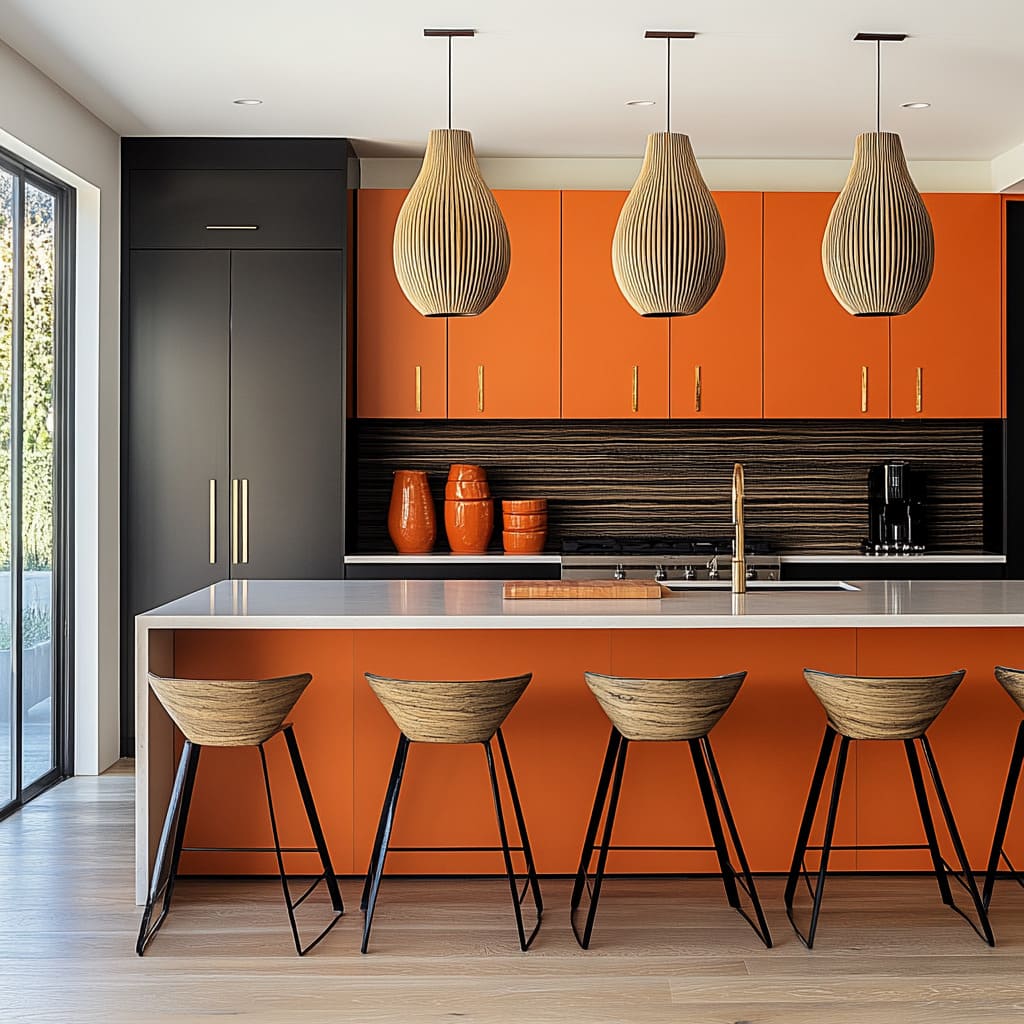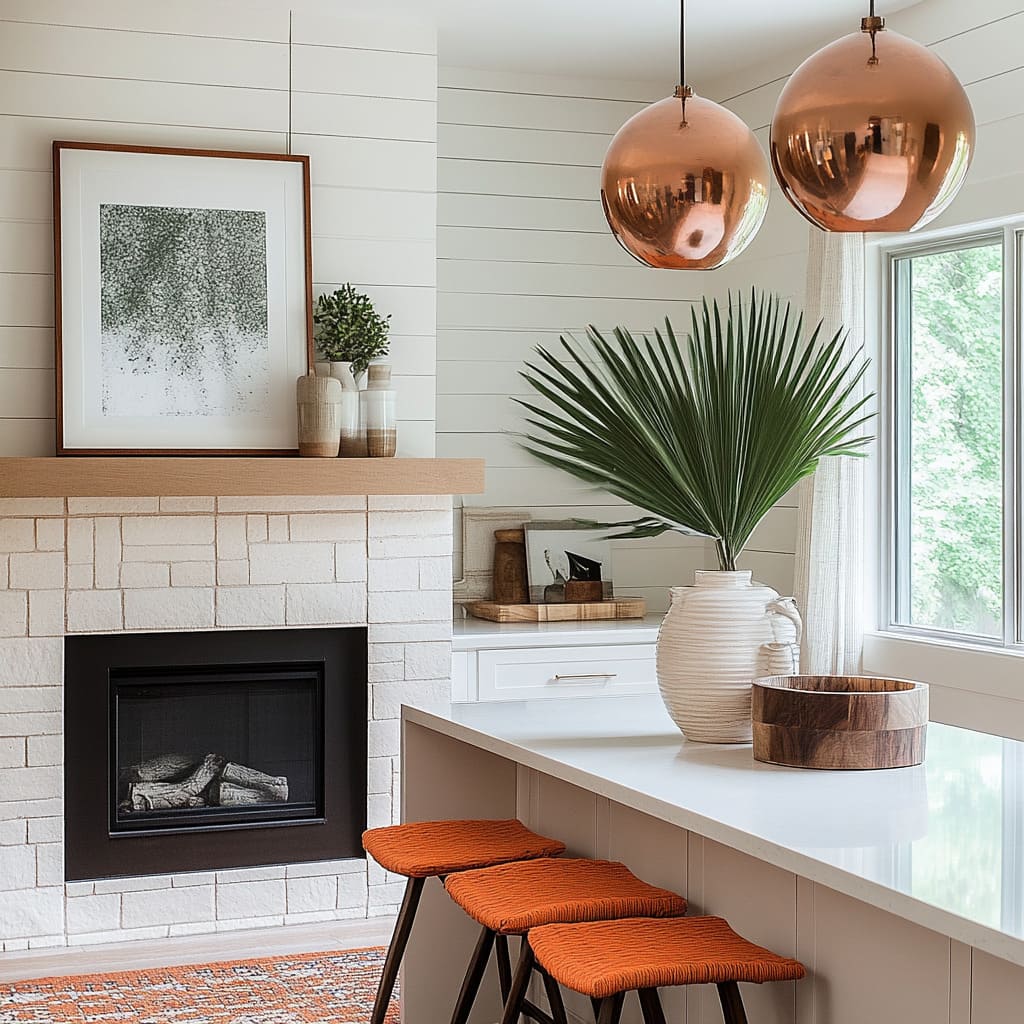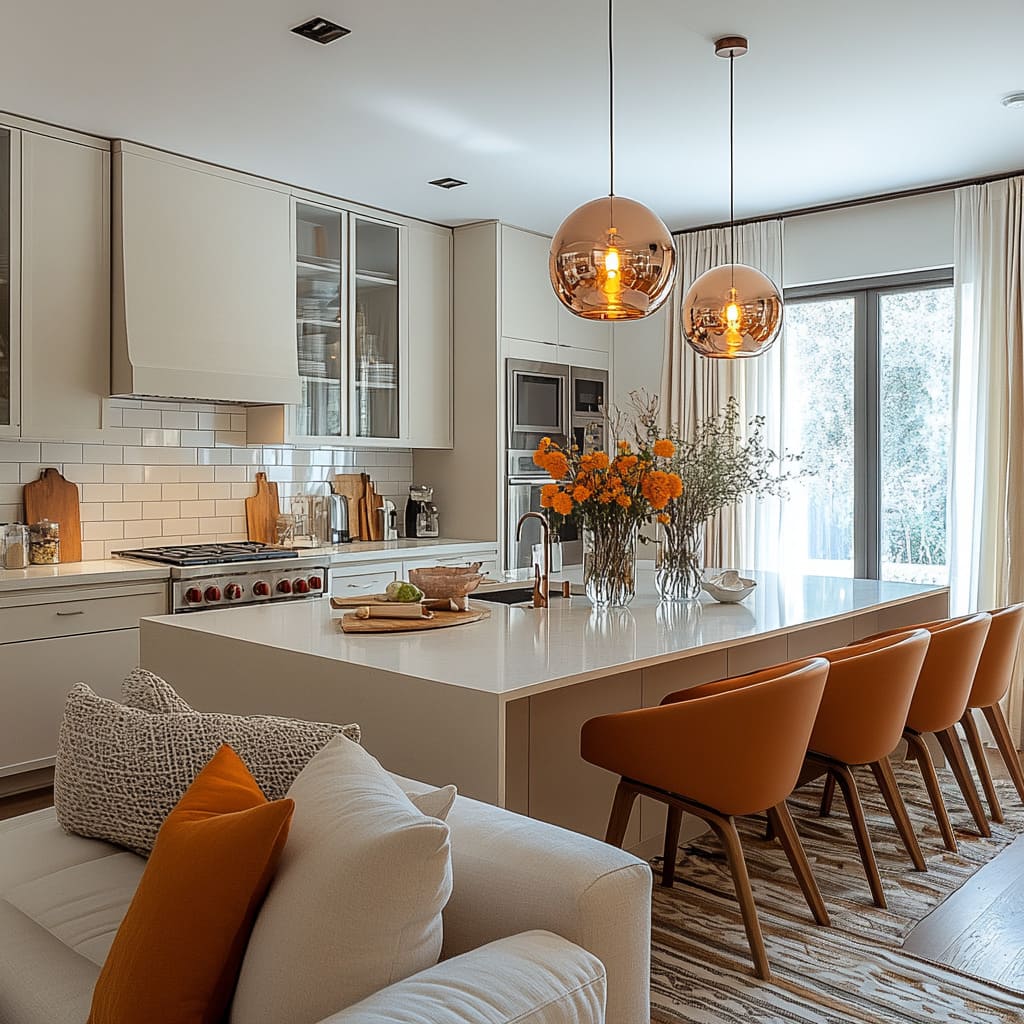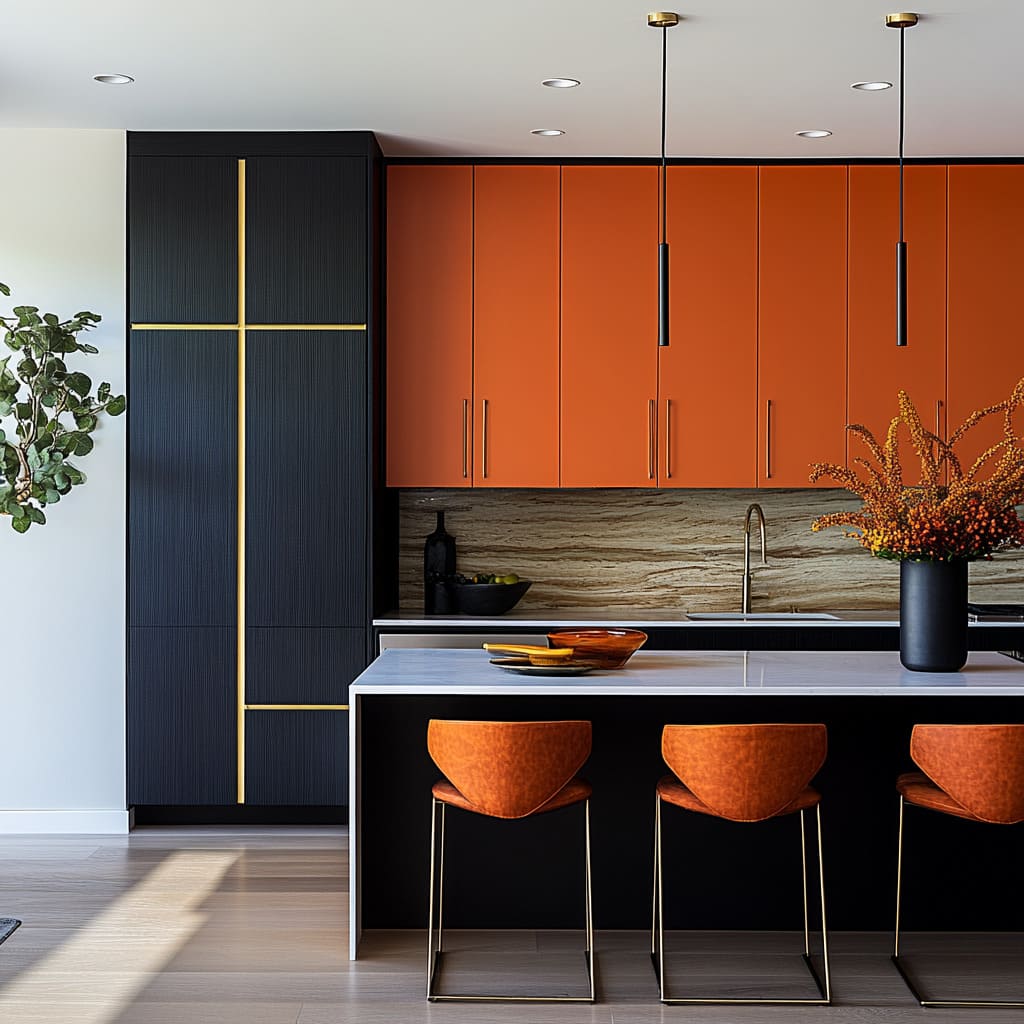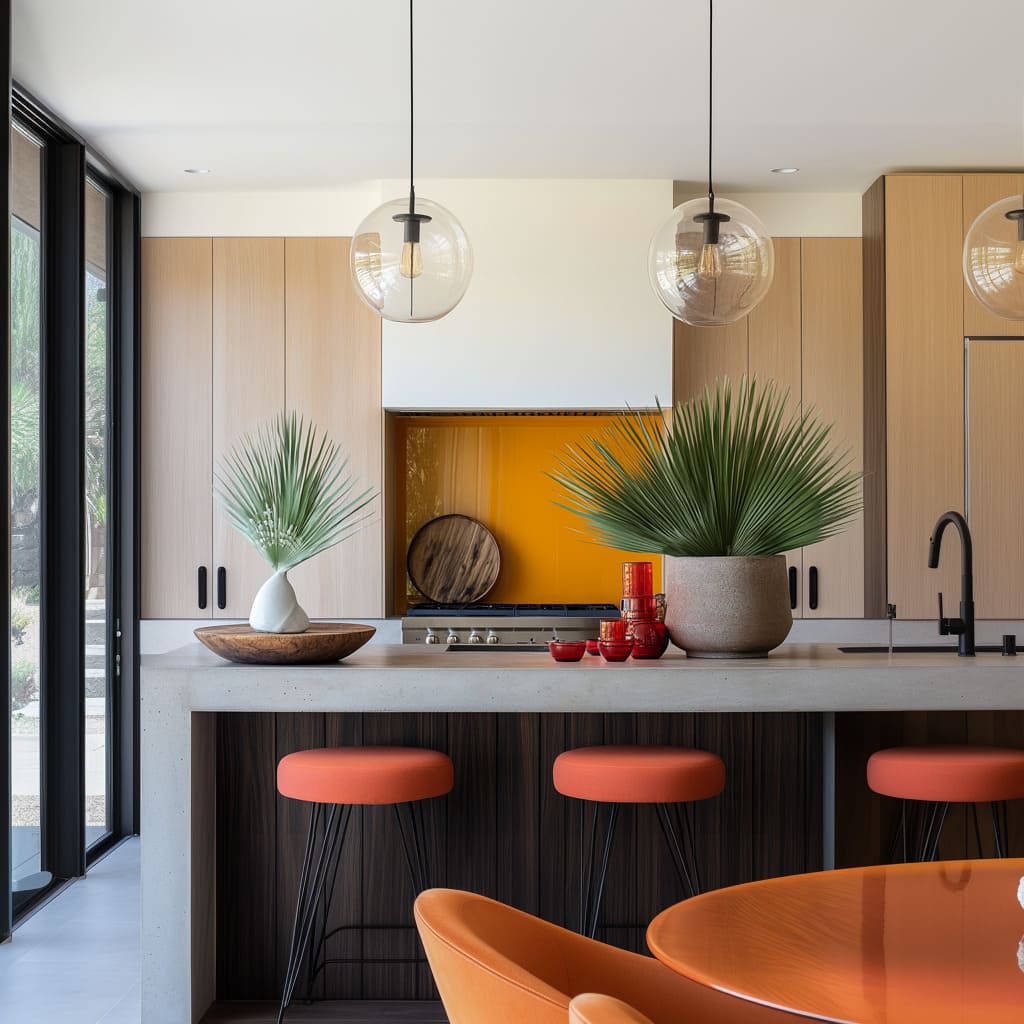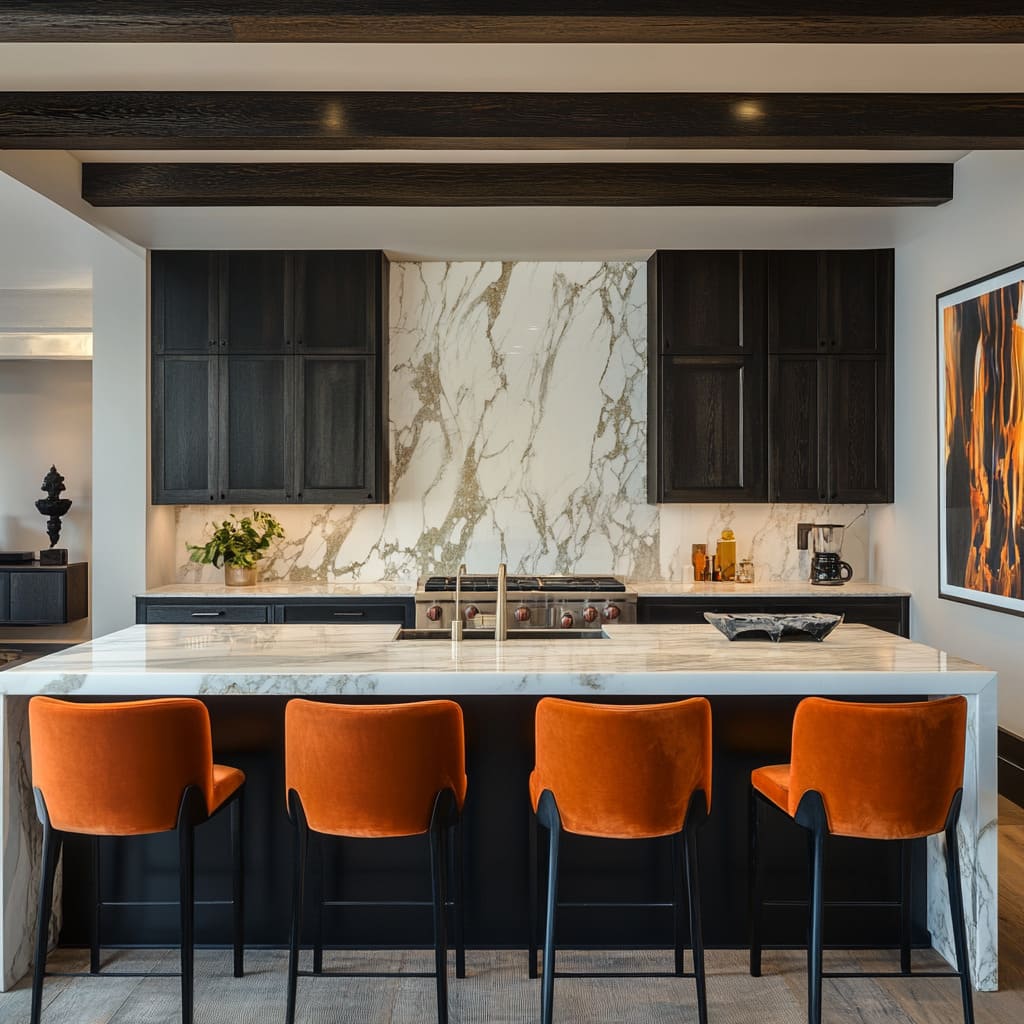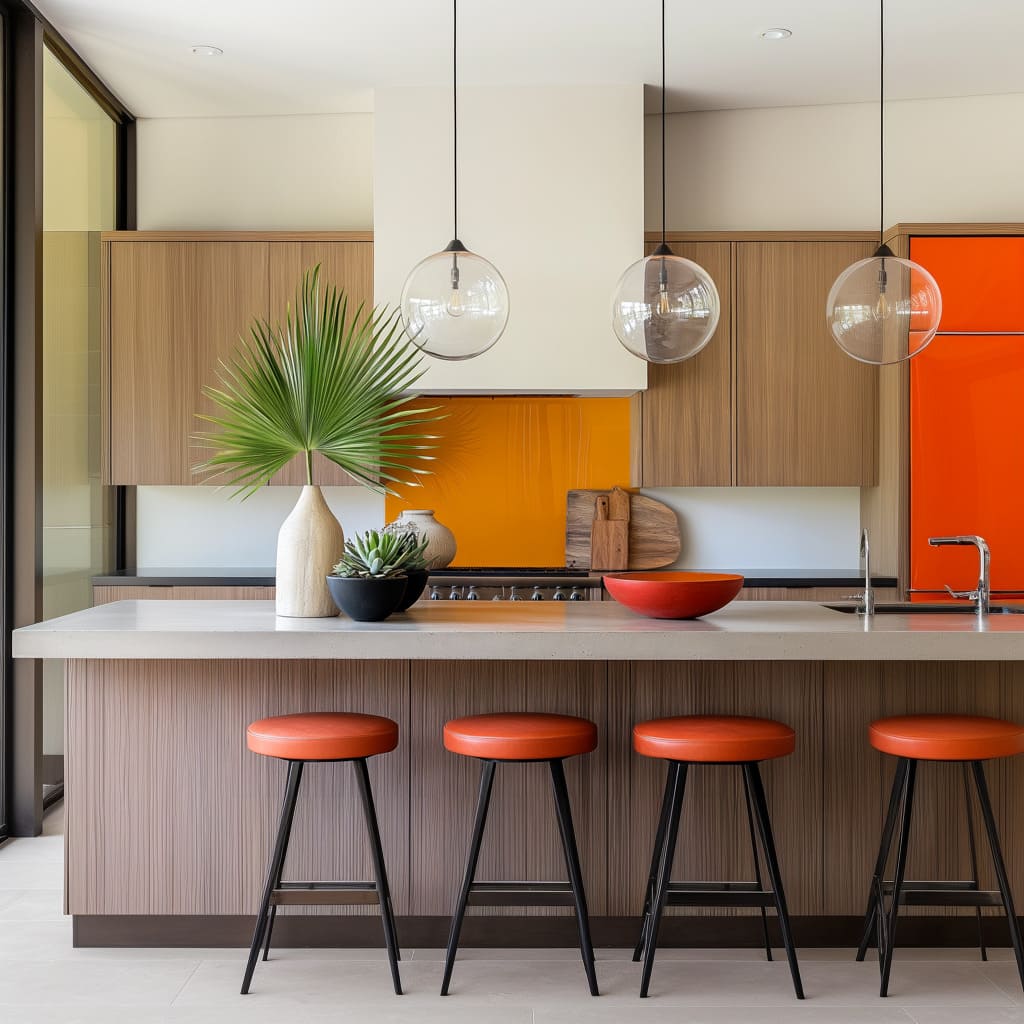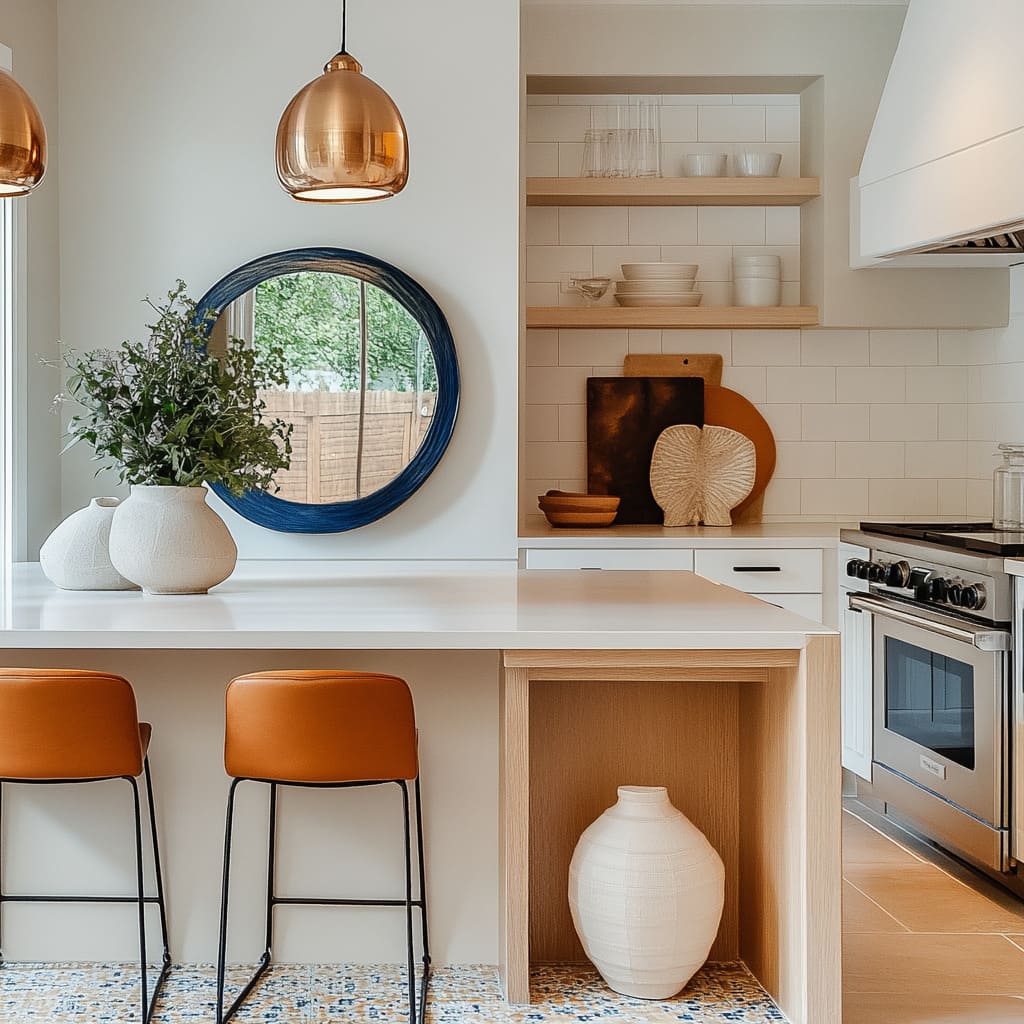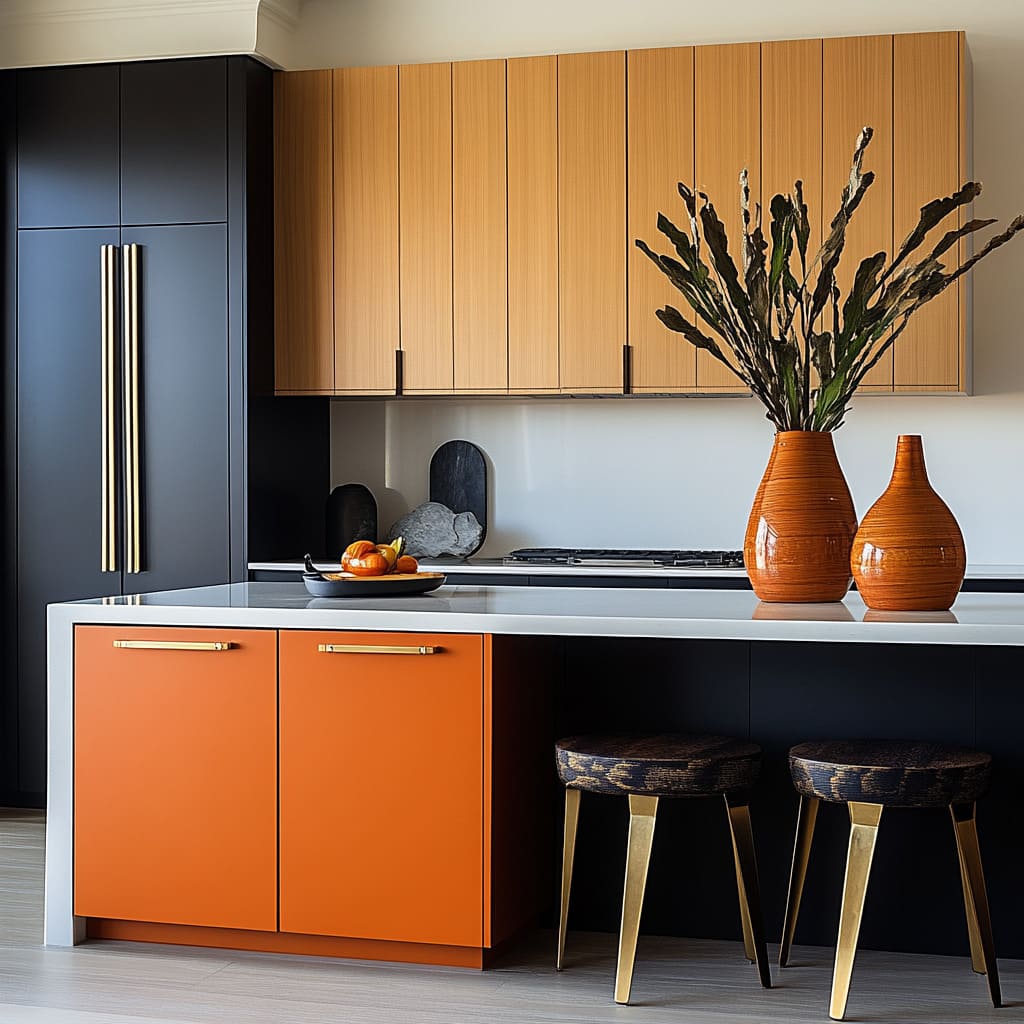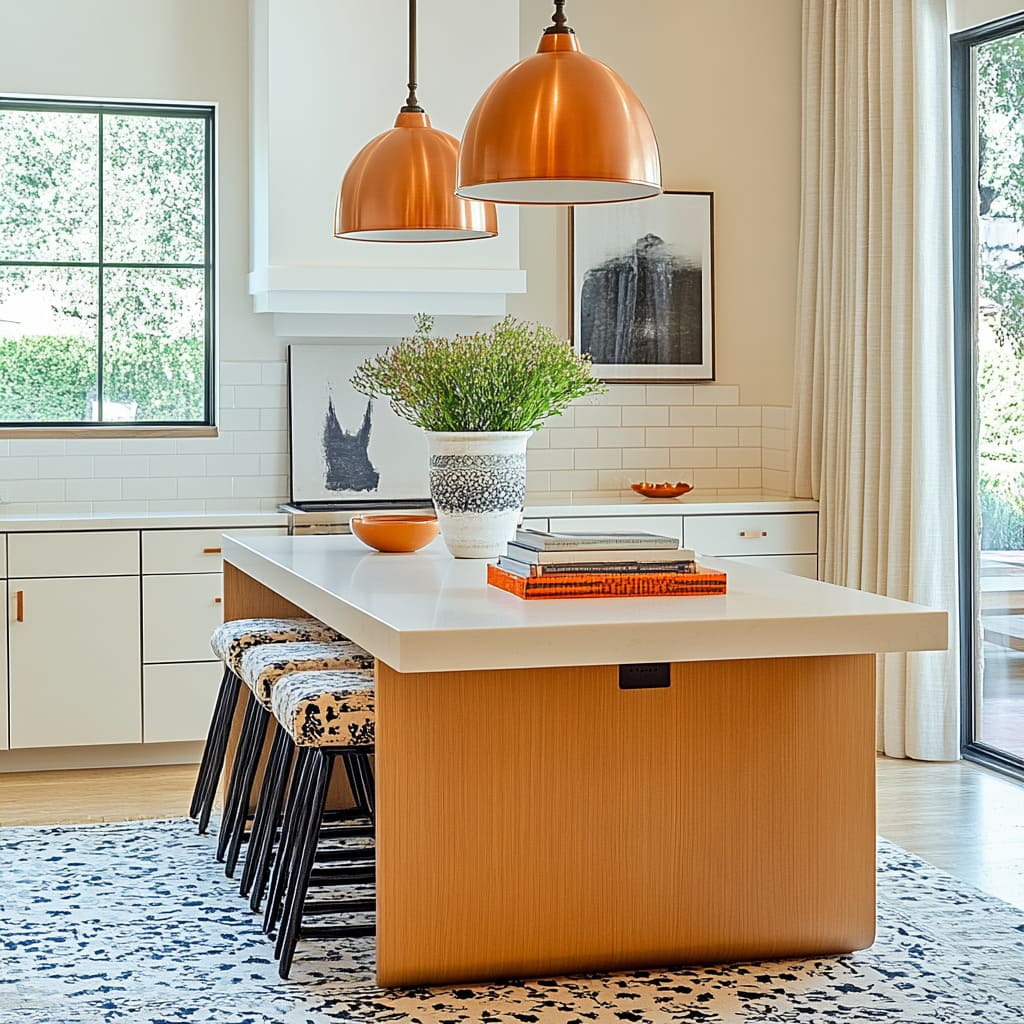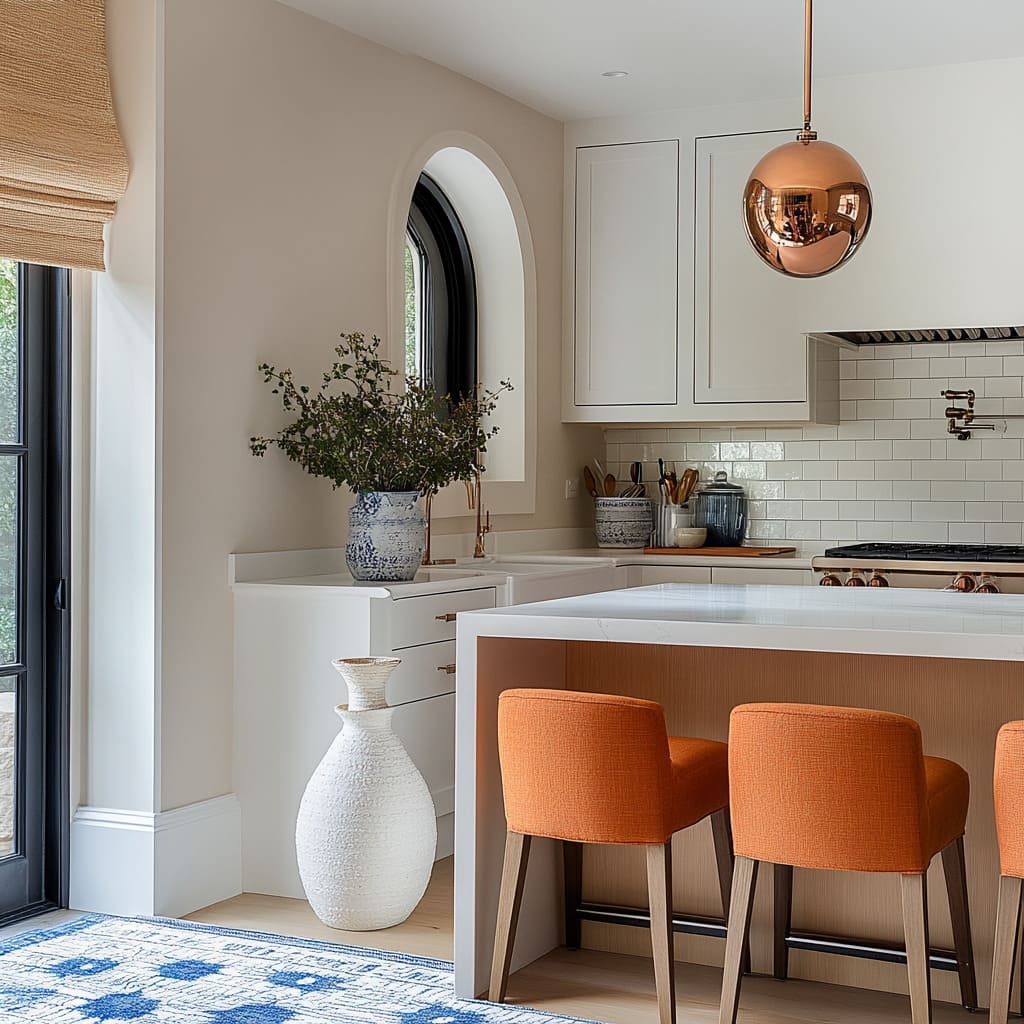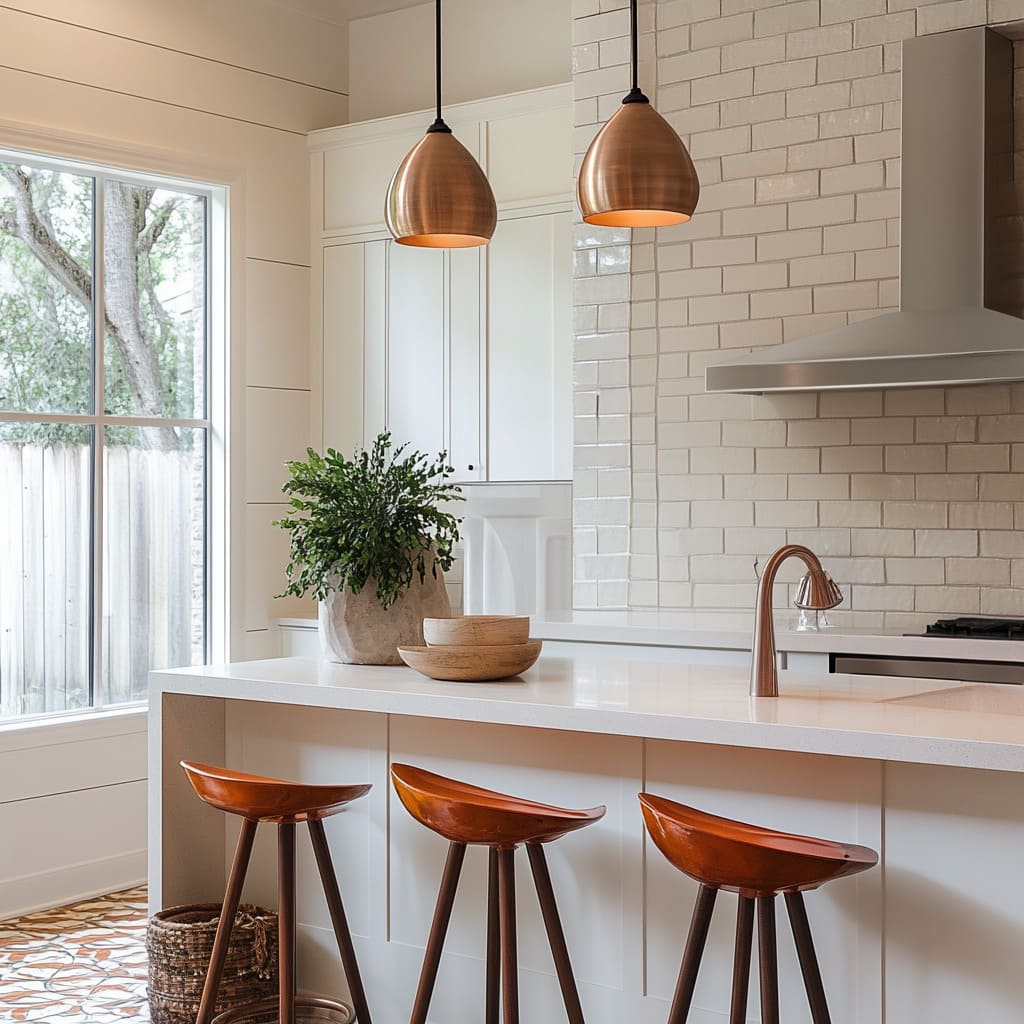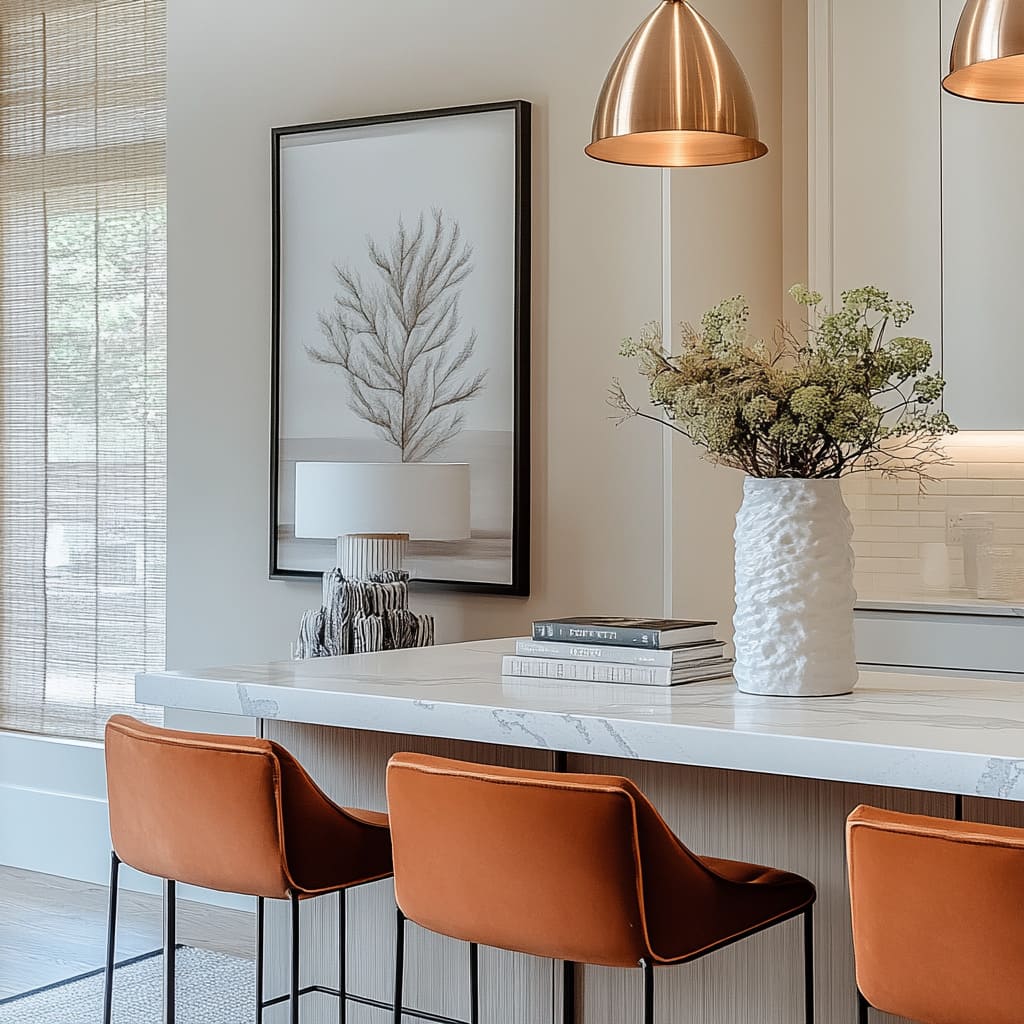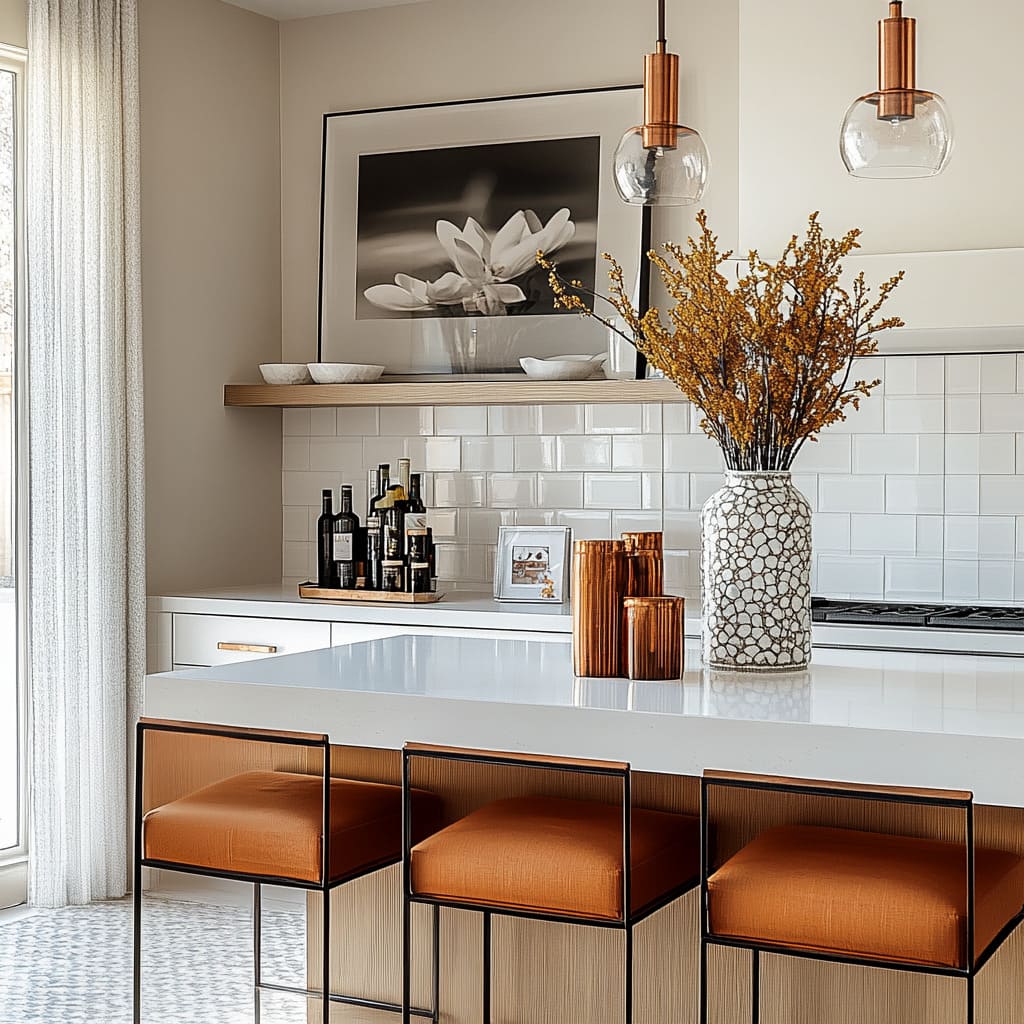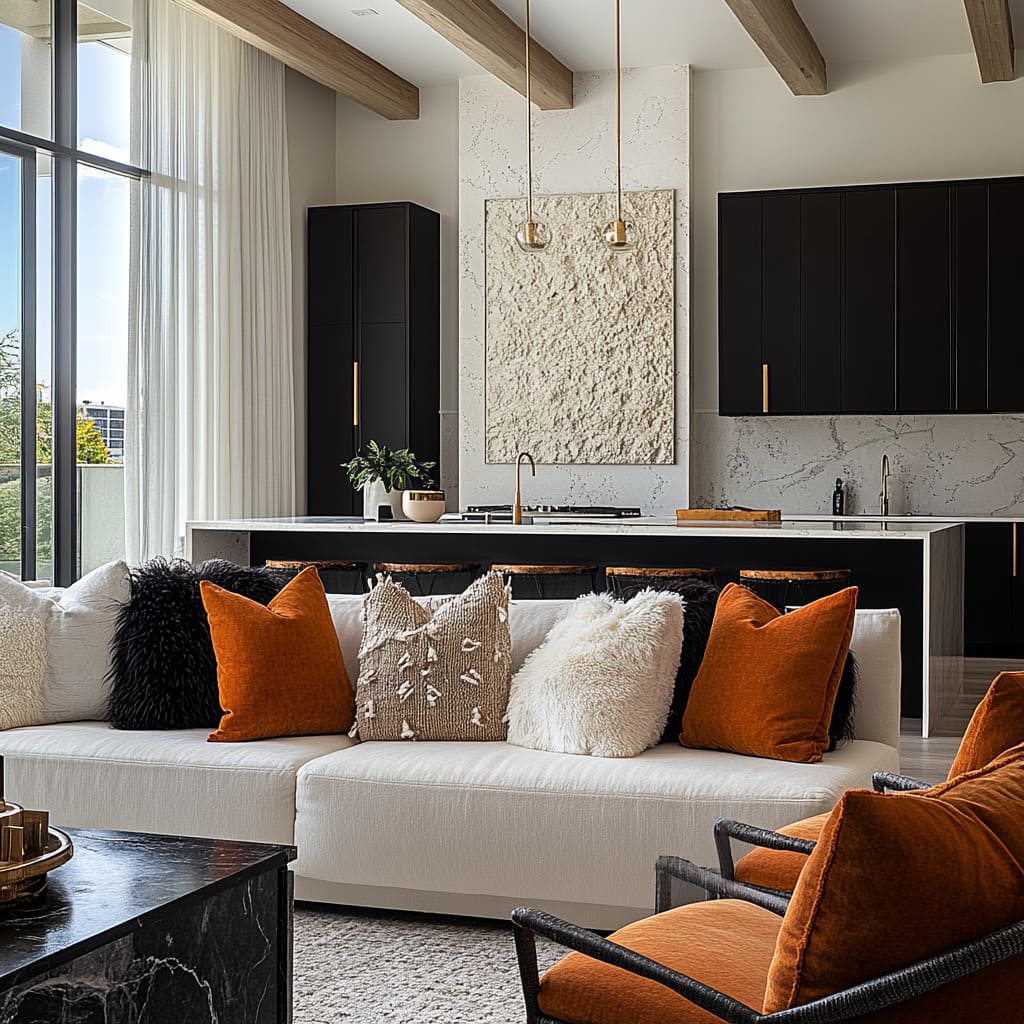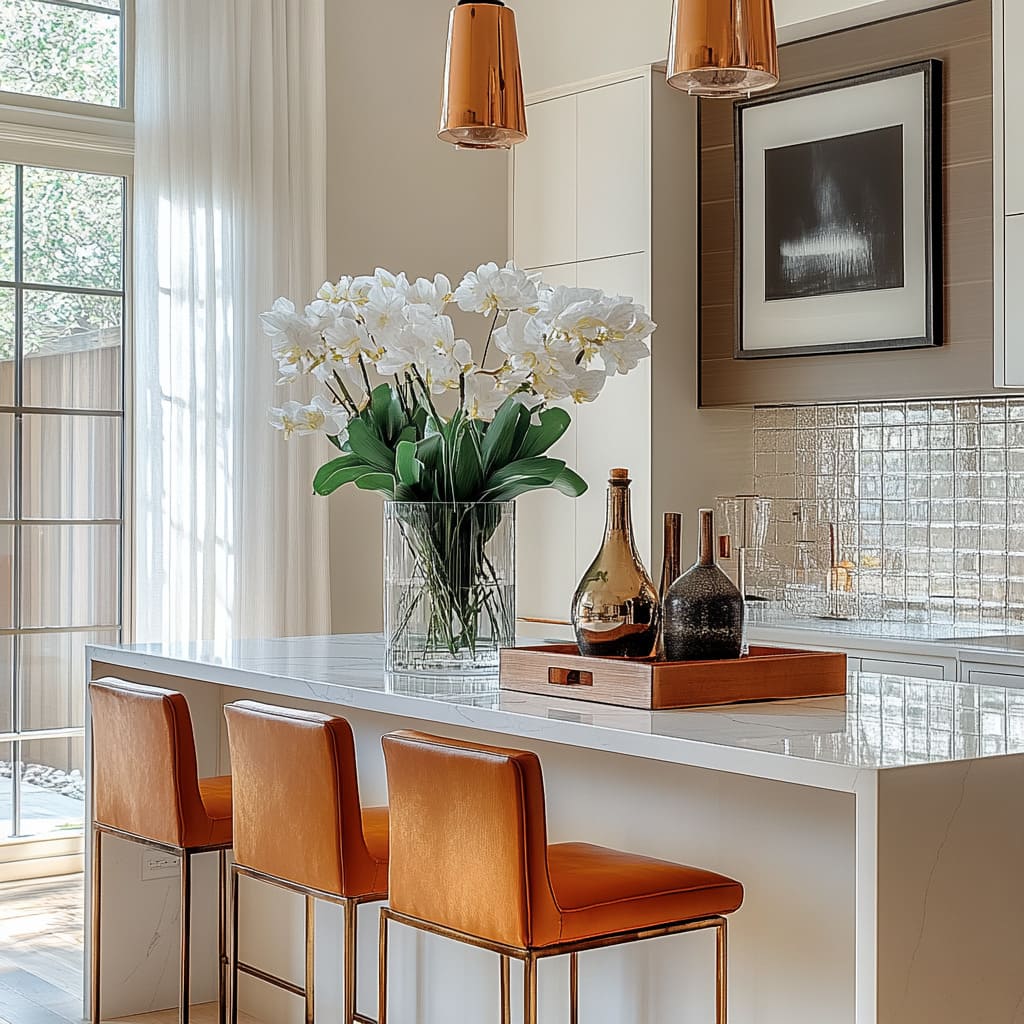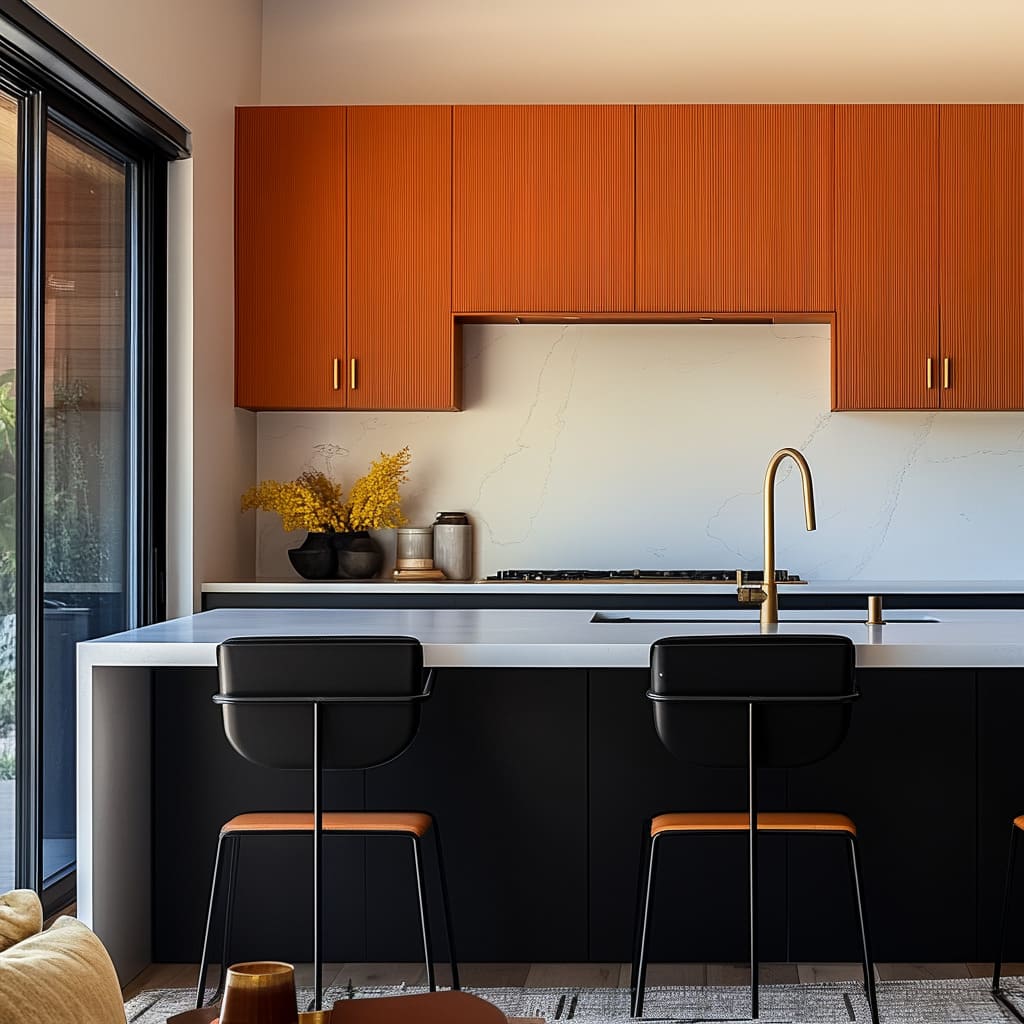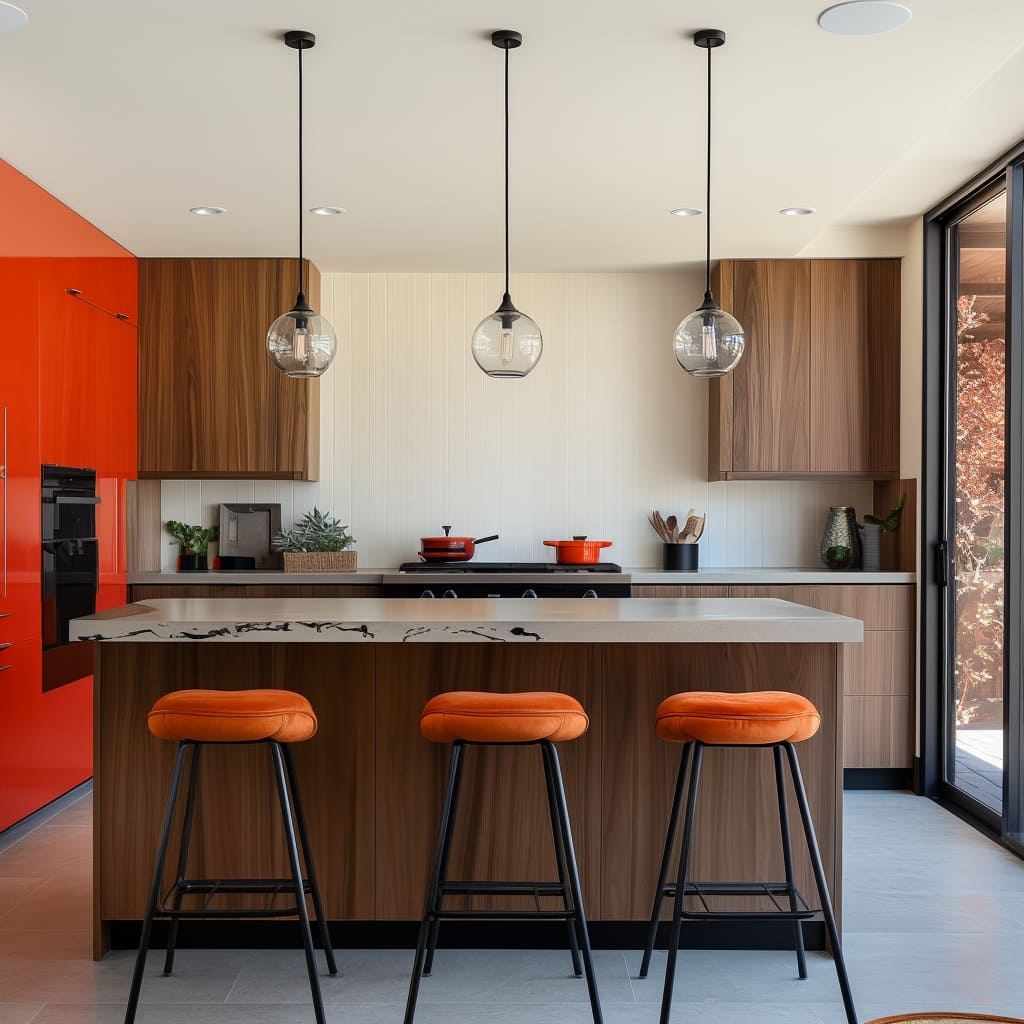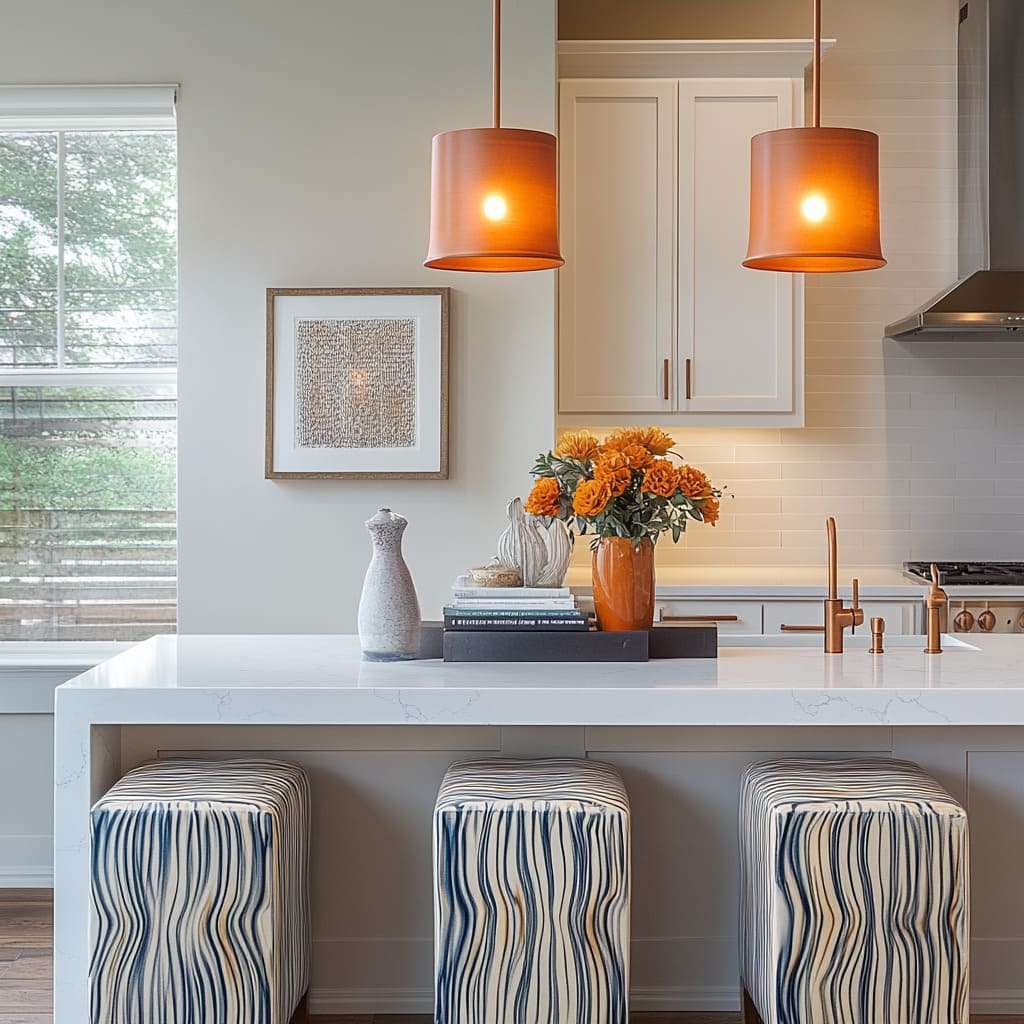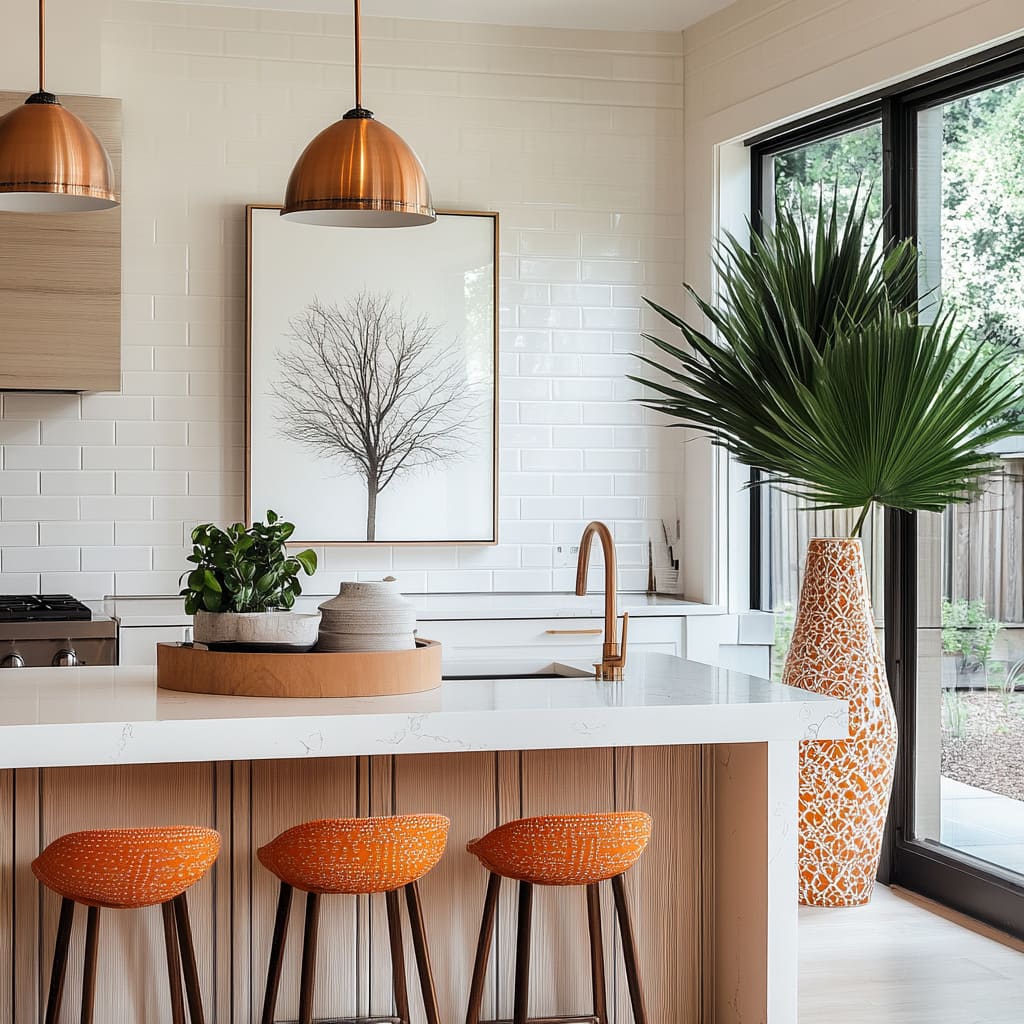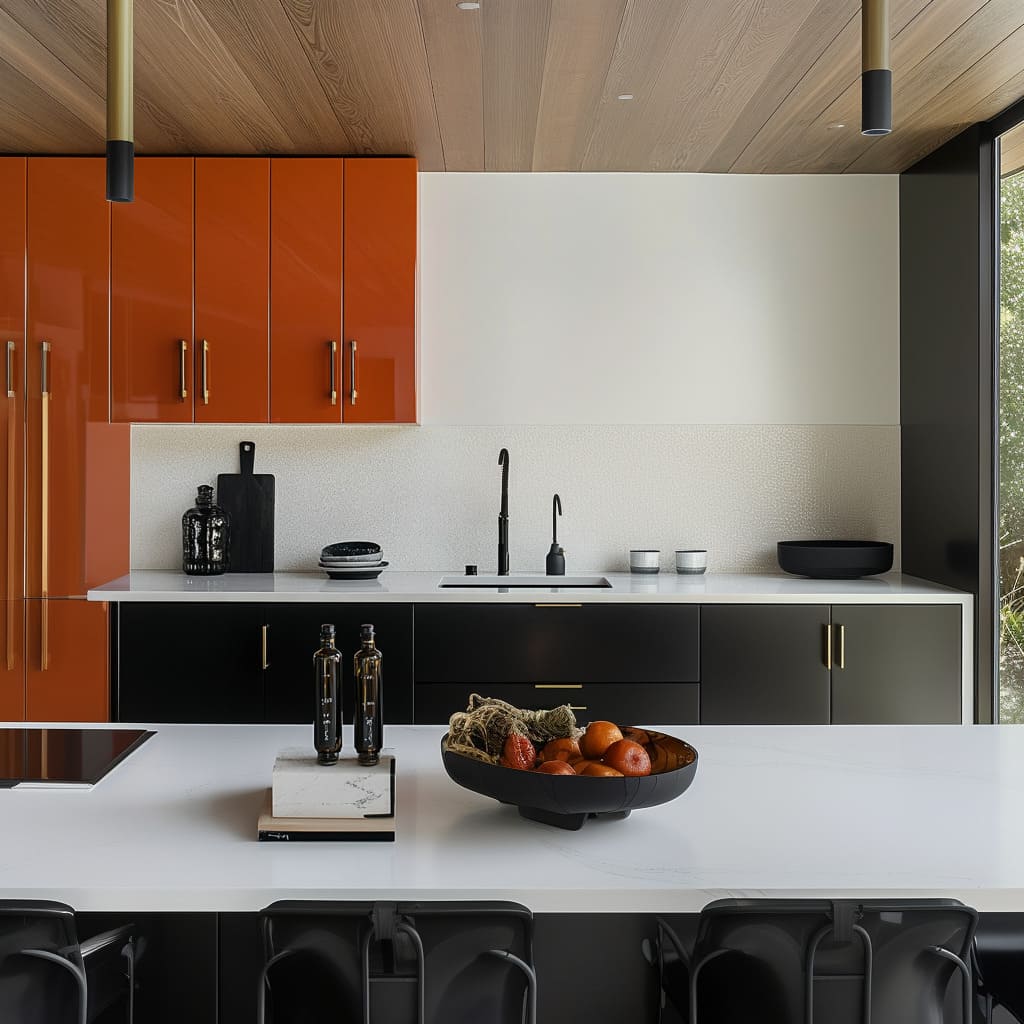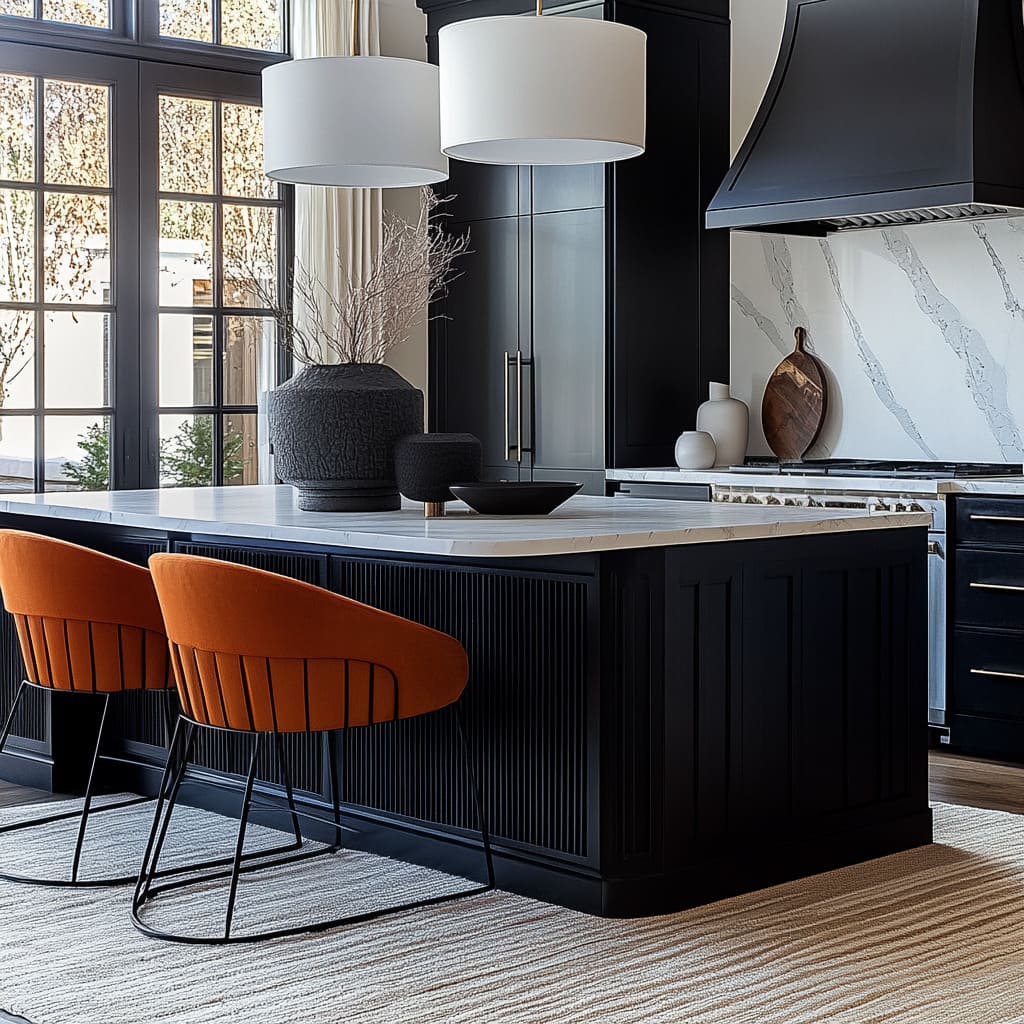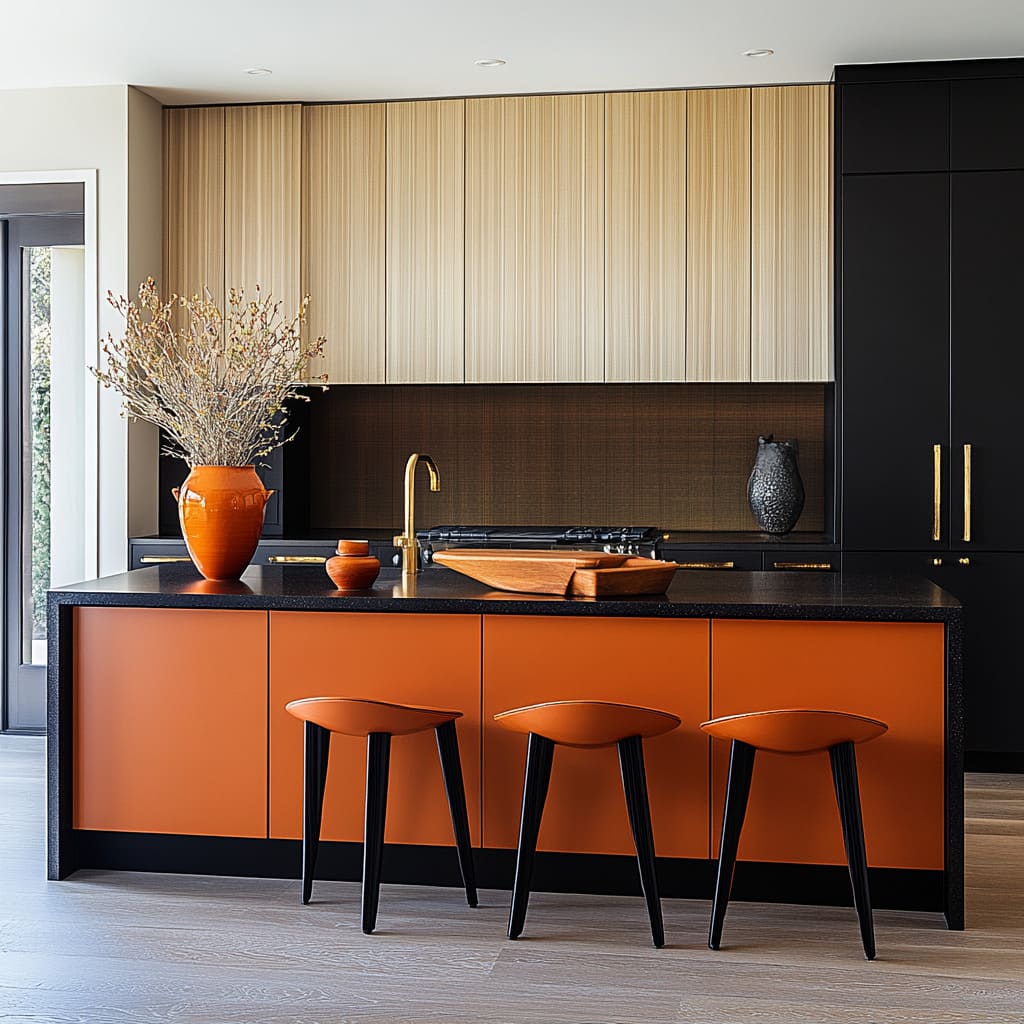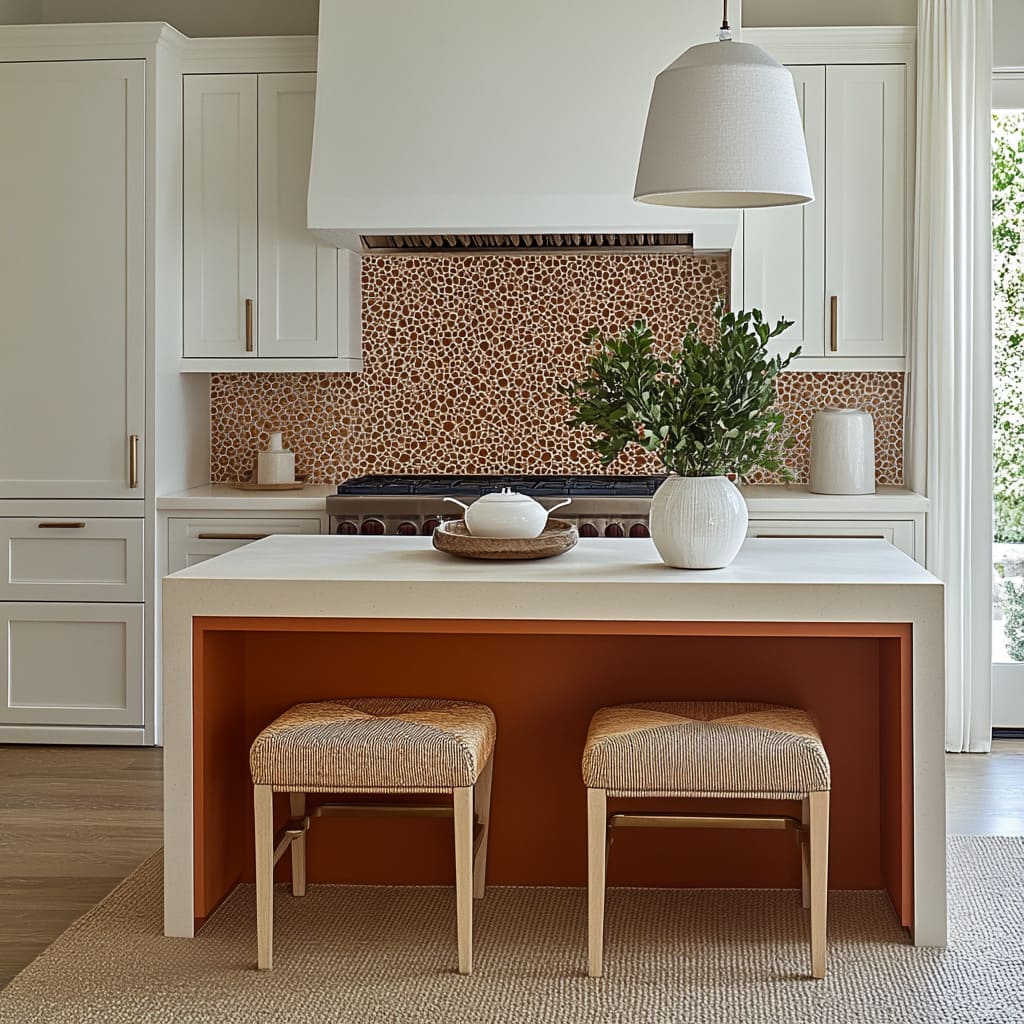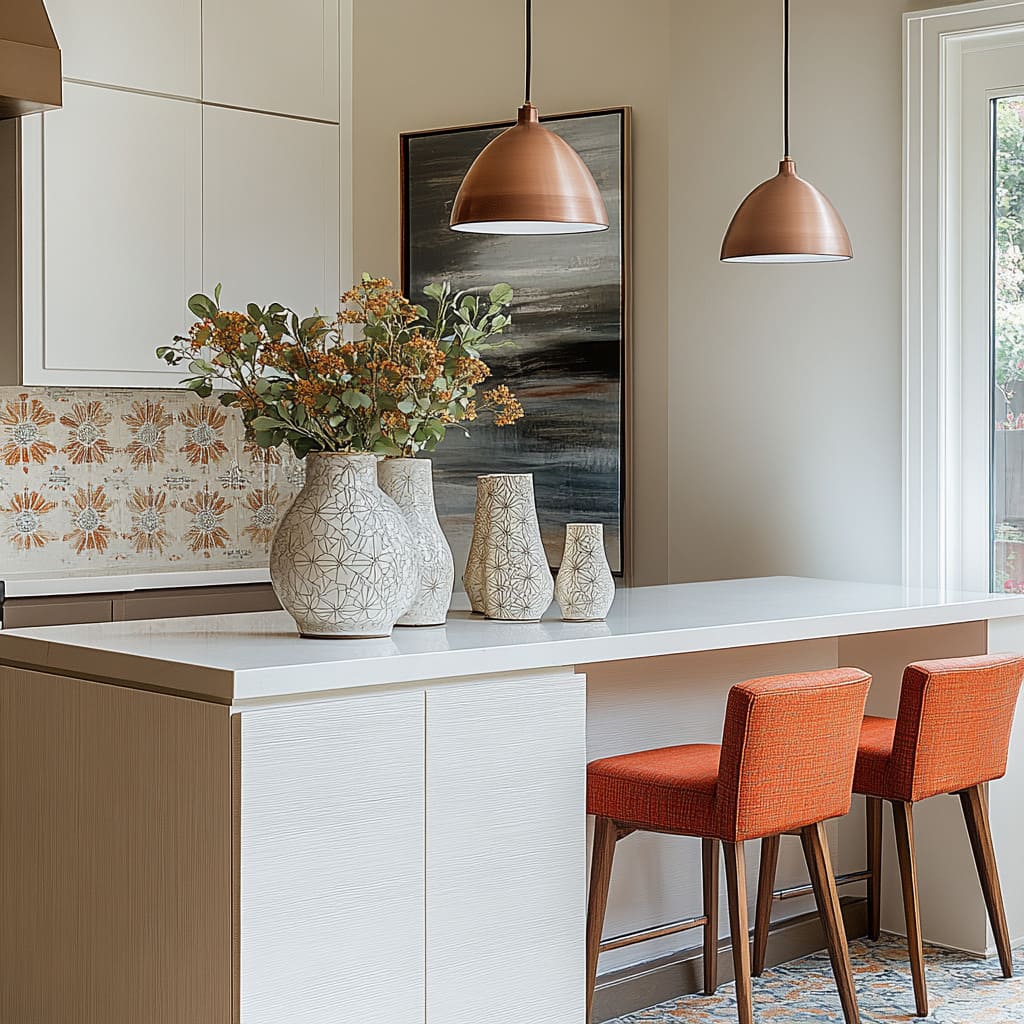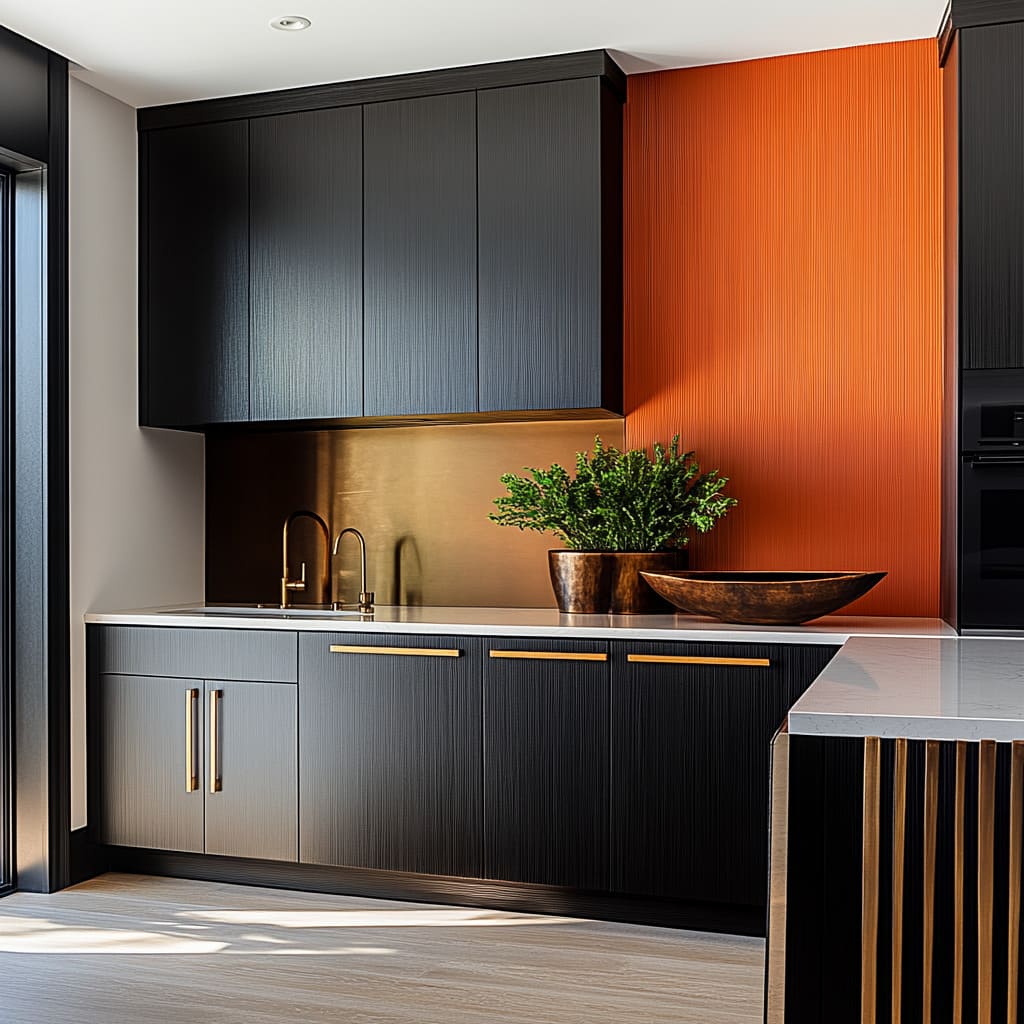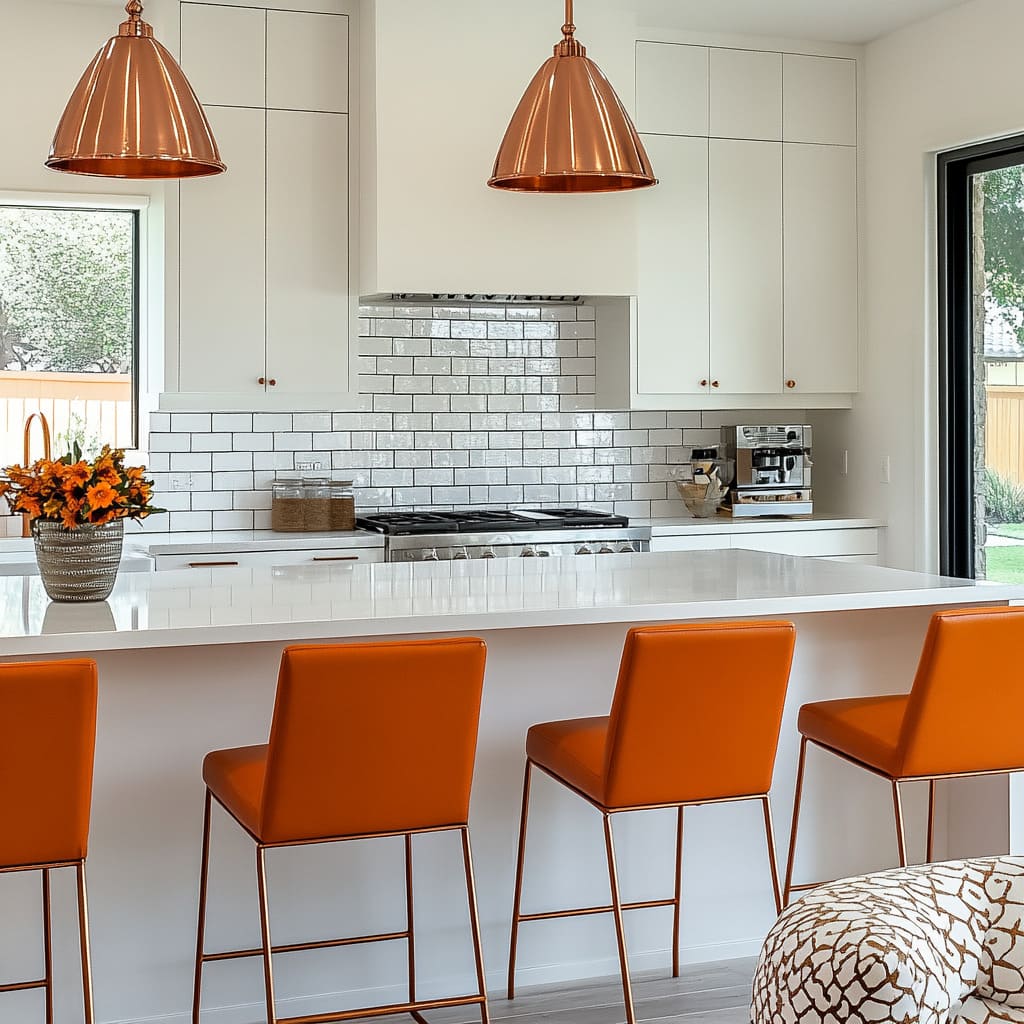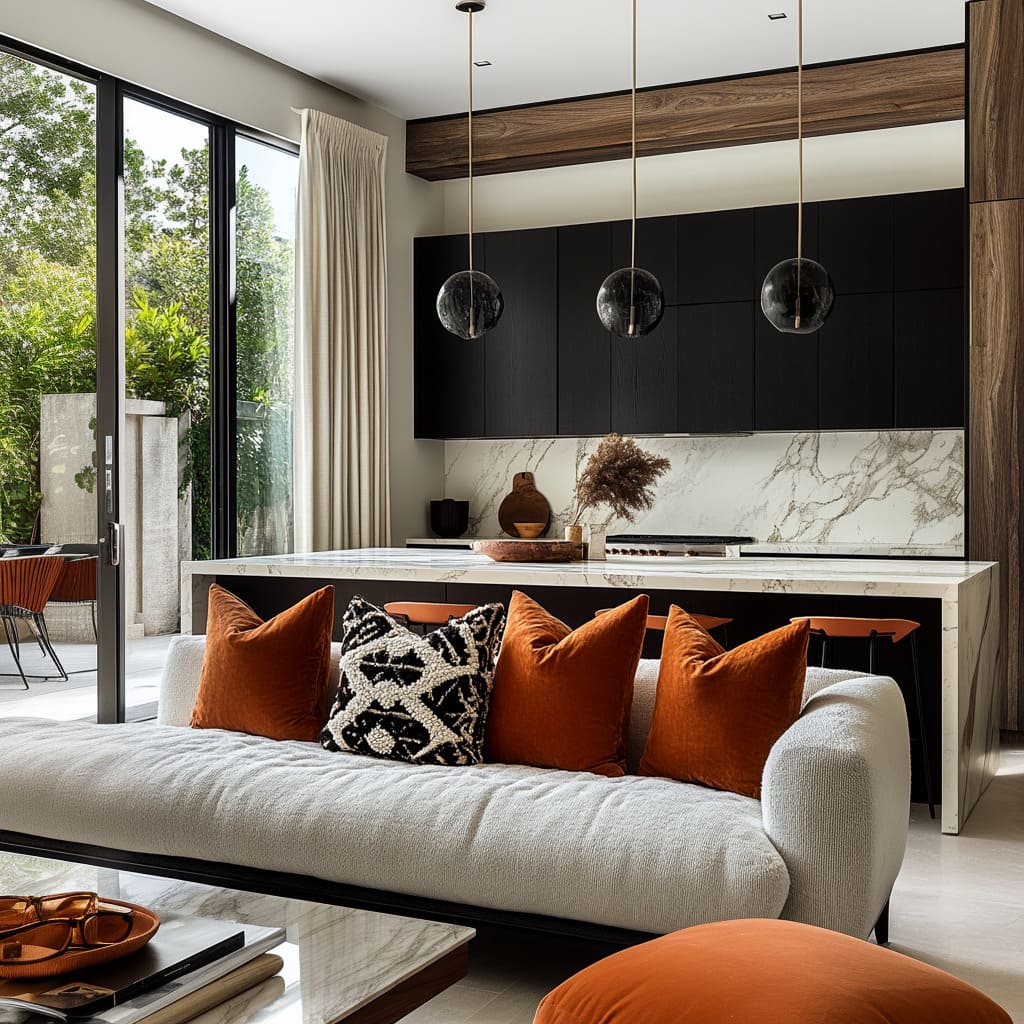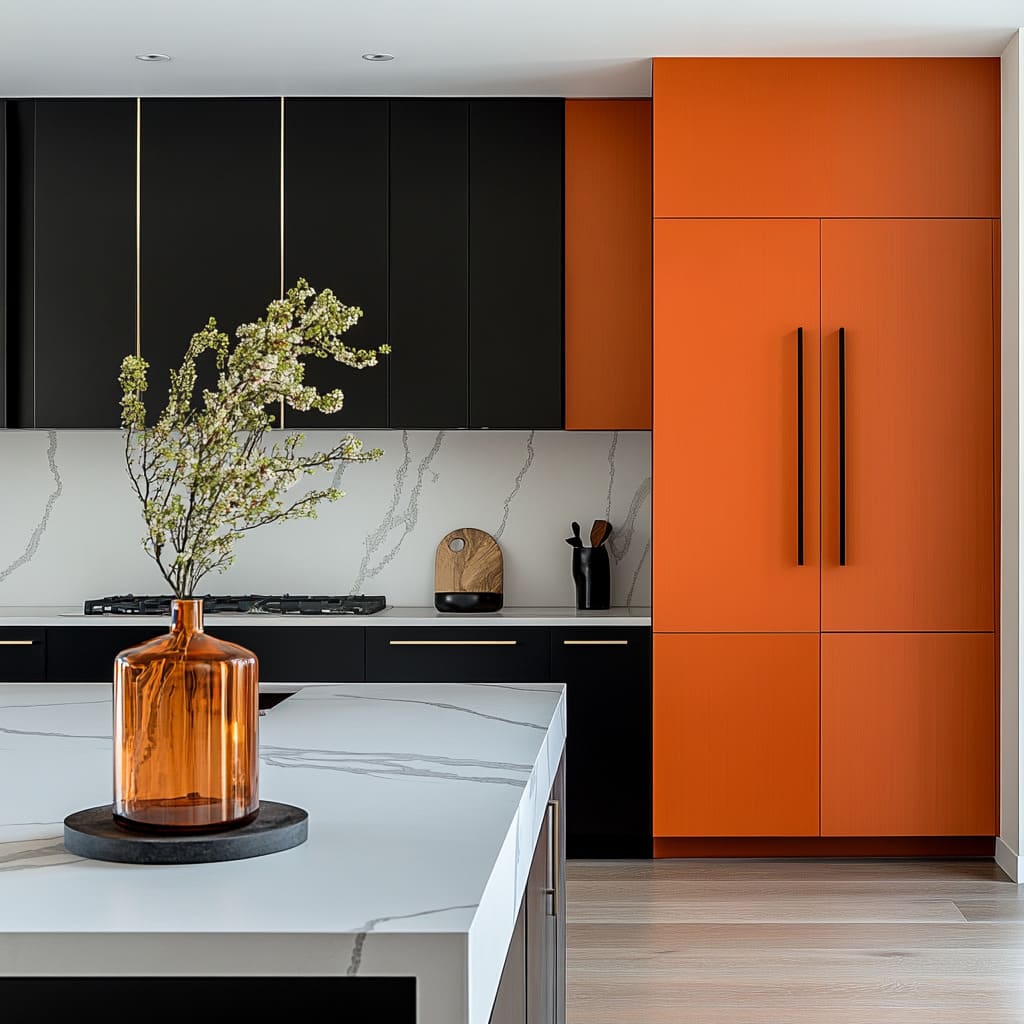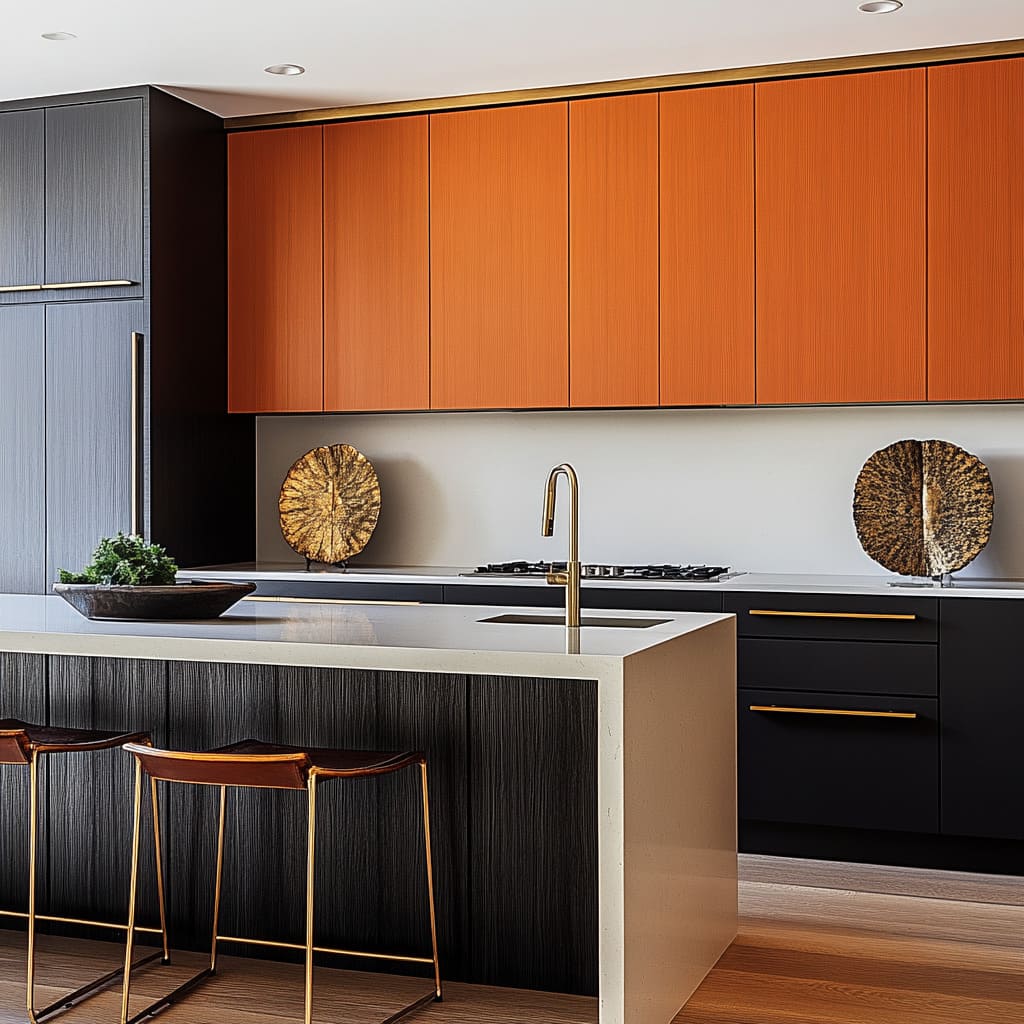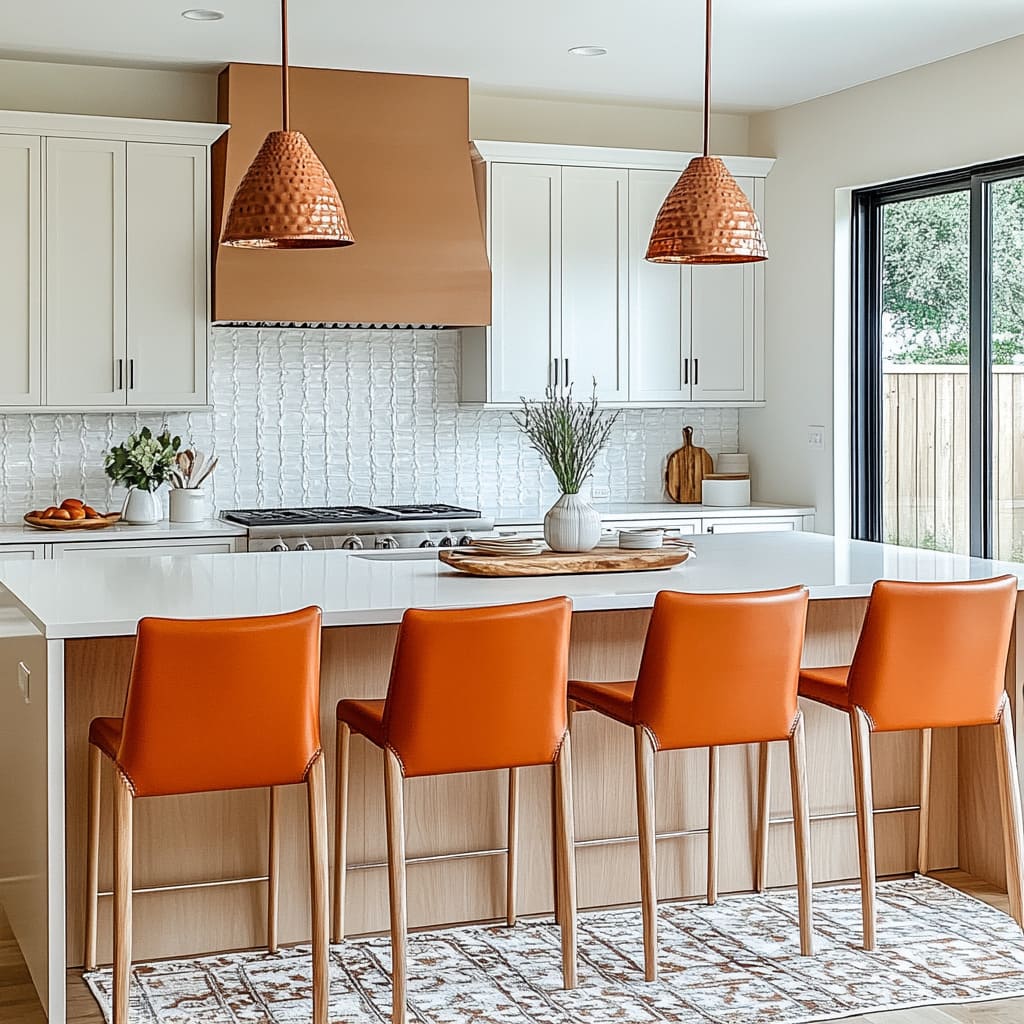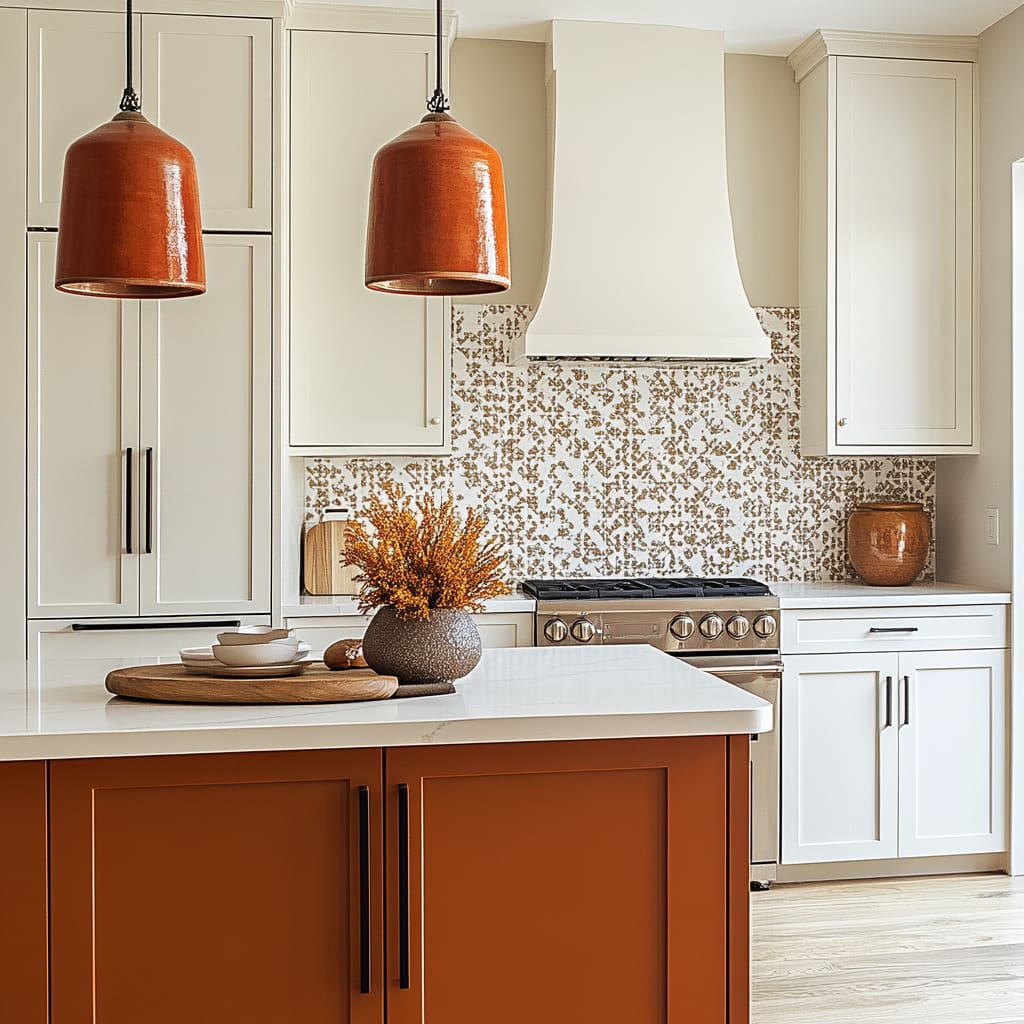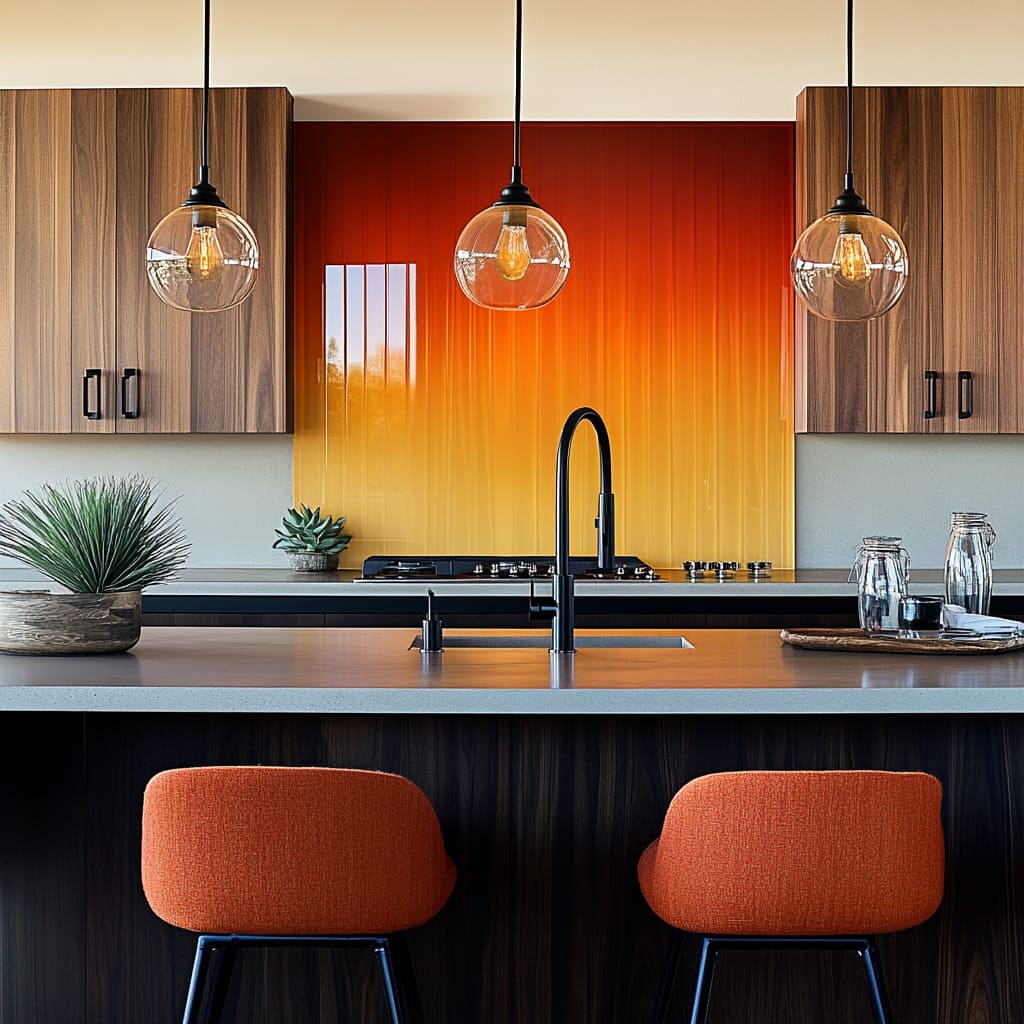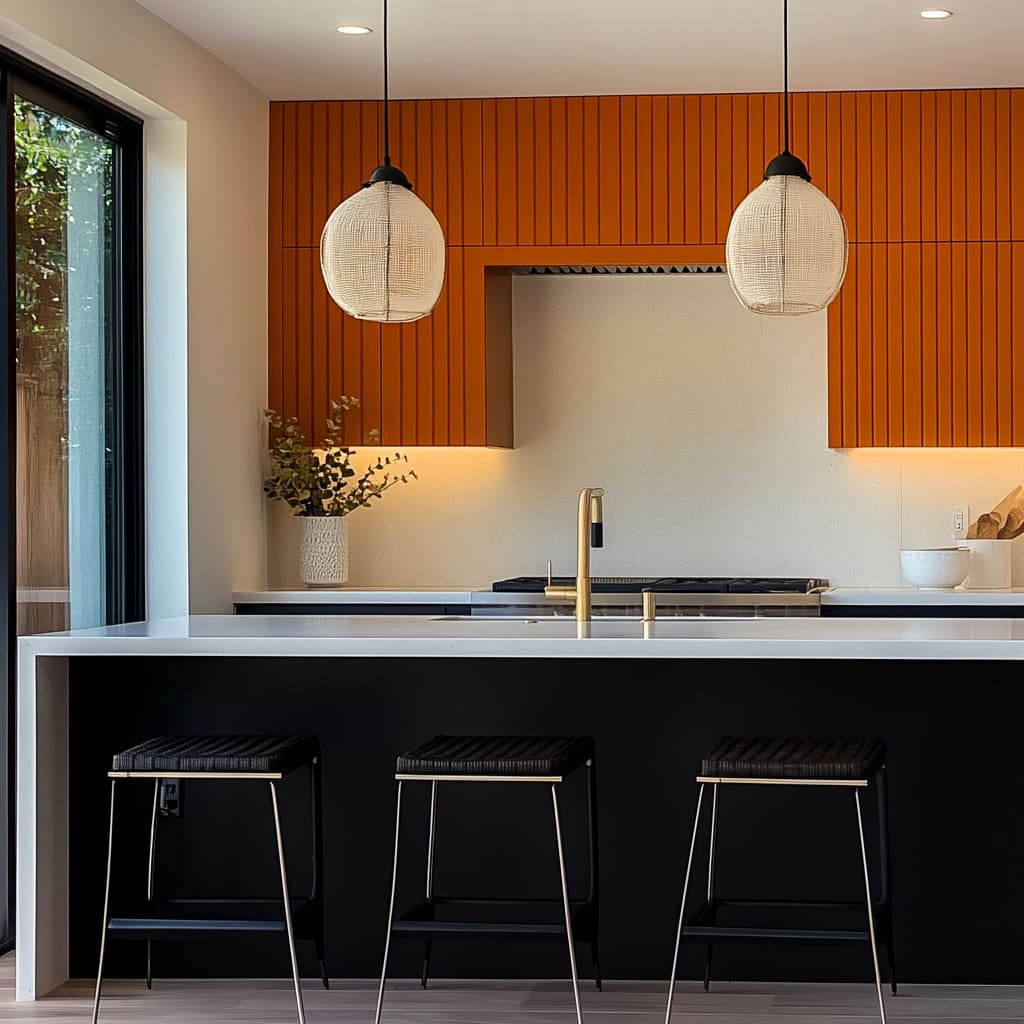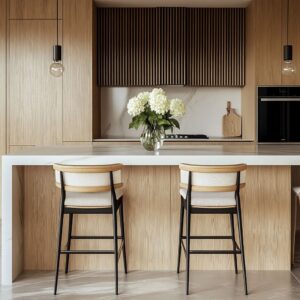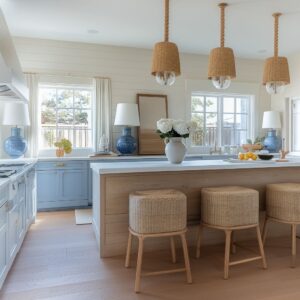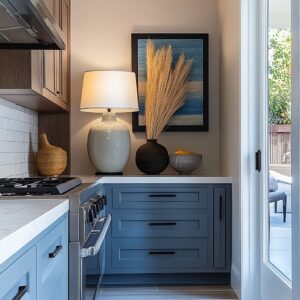When it comes to crafting a kitchen that leaves a lasting impression, the use of burnt orange opens up a world of possibilities. This warm, earthy shade injects energy and character into a space, making it stand out without feeling overpowering.
Whether used in cabinetry, accent walls, or smaller elements like seating, a burnt orange kitchen can be a showcase of thoughtful design and creativity.
The key to striking the perfect balance lies in the careful interplay of colors, textures, and finishes. Pairing burnt orange with neutral tones such as matte black, creamy whites, or soft beiges creates a harmonious palette that feels both contemporary and timeless.
This balance ensures the kitchen remains visually dynamic while maintaining a sense of cohesion. For instance, integrating burnt orange bar stools against a neutral island can draw the eye while blending seamlessly with the overall design.
Textures play a vital role in the success of this approach. Glossy finishes on cabinets can amplify light and give burnt orange a polished, modern edge, while matte surfaces offer a more understated appeal.
Introducing natural materials like wood or stone softens the boldness of burnt orange, providing depth and richness. These combinations bring warmth and texture into the kitchen, making it inviting and functional.
Lighting is another critical component. Pendant lights in copper or brass add warmth and complement the orange tones, enhancing their vibrancy without creating harsh contrasts.
Natural light, where possible, works wonders to soften the overall look, allowing burnt orange to shine in its most flattering form.
Finally, maintaining balance is essential. By reserving burnt orange for key elements—such as upper cabinets, seating, or a bold backsplash—the design remains stylish and impressive without overwhelming the space.
This focused use creates focal points that elevate the entire room, ensuring every detail works together harmoniously. With these strategies in mind, a burnt orange kitchen can become a striking centerpiece in any home, blending creativity and practicality into a truly memorable design.
Role of Burnt Orange: Emotional and Visual Impact
Burnt orange brings a unique balance to kitchen design, offering both warmth and vitality without overwhelming the space. This color strikes an emotional chord, creating an environment that feels inviting yet energetic.
Its ability to hover between vibrant and neutral tones makes it a versatile choice for a variety of settings, from contemporary apartments to traditional homes. By introducing burnt orange into a kitchen, the space becomes more than just functional—it transforms into a place where comfort and creativity thrive.
Visually, burnt orange has a magnetic quality when used with intention. In many designs, this shade is employed sparingly to draw attention to key features, such as a bold backsplash or striking burnt orange kitchen cabinets.
These focal points provide a sense of structure to the room, ensuring the overall aesthetic remains cohesive while still capturing interest. When paired with subtler hues like creamy whites, soft greys, or deep blacks, burnt orange achieves a harmonious balance that feels neither too subdued nor excessively loud.
This thoughtful use of burnt orange also helps guide the eye across the kitchen. Whether it appears in sleek cabinetry, upholstered bar stools, or even small decorative elements, its presence creates a rhythm in the design.
The result is a dynamic and engaging space that feels alive but never chaotic. In essence, burnt orange is both the heart and the highlight of these kitchens.
It creates an emotional connection while commanding visual attention, ensuring the kitchen becomes a standout feature in any home.
Key Design Strategies for Balancing Burnt Orange
Designing a burnt orange color kitchen that feels both vibrant and harmonious requires careful planning. This section explores how pairing complementary tones, using the shade sparingly, introducing varied textures, and maintaining proportionality can create a visually captivating space without overwhelming the senses.
Pairing with Neutral Tones
Neutral tones are essential in grounding the boldness of burnt orange. They act as a balancing element, preventing the space from feeling overstimulated while enhancing the richness of the color.
- Black and White: The stark contrast between matte black cabinetry and burnt orange injects sophistication and drama into the space. On the other hand, white marble countertops or backsplashes paired with burnt orange surfaces offer a lighter, more classic approach. Together, these combinations create depth, making the orange elements stand out without overshadowing the overall design.
- Beige and Cream: Warmer neutrals, such as soft beige or cream tones, gently temper the vibrancy of burnt orange. These hues complement the warm undertones of the color, resulting in a cozy and inviting aesthetic that feels balanced and approachable.
Accents, Not Overload
One of the most effective ways to incorporate burnt orange is through selective accenting. When used sparingly, the color can transform key areas into eye-catching highlights without dominating the room.
- Bar Stools: Upholstered bar stools in burnt orange instantly become focal points. Their compact size ensures the color draws attention in a controlled manner, making them an excellent choice for kitchens with large islands.
- Accent Walls or Backsplashes: A single wall or backsplash in burnt orange creates a striking contrast against neutral cabinetry or countertops. This technique ensures the space feels dynamic while maintaining a sense of restraint.
- Lighting Fixtures: Pendant lights with orange finishes, whether metallic or matte, offer subtle pops of color. Positioned above islands or counters, they integrate functionality with aesthetic appeal.
By limiting burnt orange to these intentional areas, the color feels purposeful and harmonious within the broader design.
Textural Variety
Burnt orange becomes even more dynamic when paired with diverse textures. A balance of tactile elements adds richness to the space while preventing monotony.
- Ribbed Cabinetry: Ribbed or paneled burnt orange cabinetry introduces depth and visual interest. The texture creates shadows and highlights, enhancing the color’s dimensionality.
- Velvet Upholstery: Bar stools with velvet fabric in burnt orange offer a luxurious, soft contrast to harder materials like stone or wood. This tactile interplay adds a layer of sophistication to the design.
- Glossy Finishes: High-gloss burnt orange surfaces, such as lacquered cabinets or backsplashes, exude a modern vibe. Their smoothness reflects light, making the space feel brighter and more expansive.
The thoughtful pairing of textured and smooth elements ensures that burnt orange feels versatile, adapting seamlessly to both modern and traditional styles.
Proportional Placement
Proportionality is crucial in preventing visual fatigue when using a bold color like burnt orange. Designers often reserve this shade for medium-sized elements that can serve as focal points without overwhelming the space.
- Upper Cabinets: Incorporating burnt orange into upper cabinets draws the eye upward, creating an airy and open feel. The restrained application of color ensures it complements rather than dominates the room.
- Bar Stools and Accessories: Compact items, such as stools or vases, allow burnt orange to punctuate the design without crowding it. These elements are easy to adjust or replace, offering flexibility as trends evolve.
- Avoiding Overuse on Large Surfaces: Using burnt orange sparingly on larger areas like countertops or flooring prevents the space from feeling overly saturated. Instead, focusing on smaller but impactful areas ensures the color remains fresh and inviting.
By combining these strategies—neutral pairings, intentional accents, textural diversity, and proportional placement—burnt orange integrates seamlessly into kitchen designs. These thoughtful approaches allow the color to shine as a vibrant feature while maintaining balance and harmony throughout the space.
Material Choices and Finishes
Designing with burnt orange is as much about material and finish selection as it is about the color itself. The right combination of materials and finishes can amplify burnt orange’s warmth, make it versatile, and ensure the kitchen feels cohesive and visually captivating.
Below, we explore how specific materials and finishes elevate a kitchen design and make features like a burnt orange kitchen island a show-stopping centerpiece.
Materials that Enhance Burnt Orange
The choice of materials plays a vital role in ensuring burnt orange integrates seamlessly into the overall kitchen aesthetic. Combining complementary materials creates harmony while allowing the color to stand out
Metallics:
Metallic finishes like gold and brass are natural companions to burnt orange. Their warm undertones enhance the vibrancy of the color, creating an upscale and polished look.
Examples of incorporating metallics include:
- Gold-Tone Backsplashes: A gold-toned backsplash paired with burnt orange cabinetry or islands introduces a sense of glamour. The reflective qualities of the metal catch natural or artificial light, creating an interplay of warmth and brightness.
- Brass Hardware: Cabinet pulls, faucets, and lighting fixtures in brushed or polished brass complement the earthy depth of burnt orange. The subtle shimmer from brass elements ensures the kitchen feels luxurious without overpowering the overall design.
Natural Woods:
Woodgrain introduces organic warmth and texture, balancing burnt orange’s boldness. Light or medium-tone woods work exceptionally well:
- Countertops and Islands: Pairing burnt orange with a wooden countertop softens the overall aesthetic, ensuring the space feels approachable and inviting.
- Cabinet Accents: Wooden trim or panels provide a layered look, enhancing the visual depth without competing for attention.
Surface Finishes
Selecting the right finishes is crucial to determining how burnt orange interacts with the surrounding materials and light. Whether the goal is subtle sophistication or a bold statement, finishes create nuance and texture.
- Matte Finishes: Matte black cabinetry is an understated yet impactful companion to burnt orange. The lack of shine helps ground the vibrant color, creating a balanced contrast that works in both contemporary and transitional kitchens. When paired with a burnt orange kitchen island, the matte finish creates a striking focal point without overwhelming the space.
- Glossy Surfaces: High-gloss burnt orange panels inject energy and luminosity into the kitchen. Glossy finishes reflect natural and artificial light, adding a sense of spaciousness and modernity. These surfaces are particularly effective in smaller kitchens where light reflection can enhance the sense of openness.
- Natural Stone: Marble, particularly with veining in white or warm tones, serves as an anchor for burnt orange elements. The organic patterns in the stone create visual interest, while the neutral base color tempers the boldness of orange. Using marble on countertops, backsplashes, or even as part of an island design adds sophistication and texture.
Harmonizing Materials and Finishes
The magic lies in how these materials and finishes are combined to create a cohesive design. For instance:
- A burnt orange kitchen island with a high-gloss finish could be paired with a marble countertop and brass hardware, creating a centerpiece that is both functional and visually stunning.
- Matte black cabinetry juxtaposed against a warm, natural wood floor offers a grounding effect, allowing burnt orange accents to shine in a balanced way.
By thoughtfully pairing materials like metallics, natural woods, and stone with varied finishes, designers can create a kitchen where burnt orange feels both intentional and harmonious. Whether bold or subtle, these combinations ensure the color contributes to a stylish and welcoming space.
Lighting: Enhancing Burnt Orange
Lighting plays an essential role in making a burnt orange kitchen feel balanced, welcoming, and visually captivating. It doesn’t just illuminate the space but also influences how colors and materials are perceived.
Thoughtful lighting choices can amplify the vibrancy of burnt orange while maintaining harmony in the kitchen’s overall design. Below is a detailed exploration of how lighting strategies can elevate burnt orange elements.
Pendant Lighting
Pendant lighting is a versatile way to incorporate burnt orange into the kitchen’s palette, blending functionality with aesthetic appeal.
- Orange-Tinted Glass: Pendants crafted from orange-tinted glass introduce subtle pops of color that tie seamlessly into the overall scheme. The semi-transparency of the glass diffuses light, casting a warm glow that enhances the vibrancy of burnt orange without overwhelming the space. This works especially well over islands or dining nooks.
- Copper-Toned Pendants: Copper fixtures provide a complementary metallic sheen that echoes burnt orange’s warmth. These pendants reflect light beautifully, amplifying its impact while adding a refined touch to the kitchen. The combination of metallic finishes and the earthy richness of burnt orange creates a dynamic yet cohesive aesthetic.
- Reflective Surfaces: Pendants with polished metallic or reflective finishes bounce light across the space, subtly enhancing the orange hues present in cabinetry, accents, or other design elements. This technique allows burnt orange to feel prominent without relying on large, solid blocks of color.
Natural Light
Natural light is a game-changer for any kitchen design, and its role in enhancing burnt orange is particularly noteworthy.
- Large Windows: Kitchens featuring expansive windows maximize the use of daylight, allowing it to soften the boldness of burnt orange elements. When sunlight streams in, it highlights the color’s warmth, making it feel more organic and less intense.
- Strategic Placement: Designers often place burnt orange accents near natural light sources, such as windows or glass doors. This strategy ensures the color remains illuminated throughout the day, emphasizing its vibrancy and depth. For example, burnt orange bar stools positioned near a window can act as a subtle yet eye-catching focal point.
- Daylight Diffusion: Sheer curtains or frosted glass can diffuse natural light, softening its intensity and creating a more uniform glow. This prevents harsh shadows and ensures burnt orange elements are evenly lit, enhancing their visual appeal.
Layered Artificial Lighting
Layering artificial lighting ensures the kitchen remains functional while highlighting its design features, particularly burnt orange.
- Warm-Toned LEDs: LED lights with a warm color temperature (typically in the range of 2700K–3000K) are ideal for complementing burnt orange. These lights enhance the richness of the color, making it feel more inviting and grounded. Warm lighting is particularly effective in accentuating the orange tones in cabinetry, island surfaces, or decorative elements.
- Avoiding Cool Lighting: Cool-toned lights, often with a bluish tint, clash with burnt orange’s warm undertones. They can make the color appear dull or even out of place, disrupting the kitchen’s visual harmony. Sticking to warm or neutral lighting ensures the space feels cohesive.
- Spotlights and Task Lighting: Spotlights directed at burnt orange features, such as an island or a backsplash, can highlight these elements without making them overpowering. Task lighting under cabinets or above countertops ensures practicality while enhancing the kitchen’s aesthetic.
The Synergy of Light and Color
The interplay between lighting and burnt orange elements is what brings the space to life. Combining natural light with strategically placed artificial lighting creates a layered effect, ensuring the kitchen feels dynamic and balanced.
For example:
- A burnt orange kitchen island illuminated by pendant lights with warm metallic finishes becomes the centerpiece of the space, drawing the eye without dominating the design.
- Layering natural light during the day with warm-toned LEDs in the evening transitions the kitchen seamlessly between brightness and coziness, showcasing burnt orange’s versatility.
By thoughtfully integrating lighting into the design, burnt orange becomes more than a color—it transforms into a feature that radiates warmth and personality throughout the kitchen.
Spatial Planning and Burnt Orange Distribution
Spatial planning is essential when incorporating bold colors like burnt orange into a kitchen design. This section explores how thoughtful placement, combined with strategic color distribution, ensures a balanced and visually pleasing outcome.
Horizontal and Vertical Balance
Vertical Placement: Elevating the Eye
Using burnt orange in vertical elements creates visual interest at eye level and above. Upper cabinets in burnt orange introduce a striking element that naturally draws the gaze upward, giving the space a sense of height.
Similarly, burnt orange pendant lights above an island or dining area not only provide practical lighting but act as design anchors that enhance the kitchen’s vertical balance. This approach works particularly well in kitchens with high ceilings, as the vibrant hue fills visual voids while maintaining sophistication.
Horizontal Placement: Grounding the Space
Horizontally, burnt orange elements like bar stools or cabinetry on lower levels provide a sense of stability and cohesion. For example, placing burnt orange seating at a kitchen island ensures the color remains visually anchored.
This grounding effect is especially impactful when paired with contrasting neutrals like white countertops or matte black lower cabinetry. The horizontal alignment of burnt orange across seating or cabinetry creates a rhythm that guides the eye through the space, making the design feel intentional and harmonious.
Interplay Between Levels
When burnt orange is used across both horizontal and vertical planes, it creates a cohesive dialogue within the kitchen. For instance, pairing upper burnt orange cabinets with matching stools below creates a balanced look that feels connected without being repetitive.
The contrasting interplay of these elements ensures visual equilibrium, allowing burnt orange to stand out without overwhelming the design.
Open vs. Enclosed Spaces
Open-Concept Kitchens: Bridging Spaces
In open-concept layouts, burnt orange acts as a unifying thread that ties the kitchen to adjacent living areas. For example, incorporating burnt orange bar stools in the kitchen can be echoed through pillows, throws, or rugs in the living space.
This continuity creates a seamless flow between zones, giving the overall design a sense of coherence. Additionally, open layouts often benefit from color accents that provide structure, and burnt orange can define the kitchen area while maintaining harmony with its surroundings.
Enclosed Kitchens: Energizing the Space
In more traditional enclosed kitchens, burnt orange takes on the role of a focal point, energizing the room without overwhelming its boundaries. A burnt orange backsplash or bold cabinetry can introduce vibrancy, breaking up the monotony of neutral walls or countertops.
In these spaces, the color becomes a deliberate choice, turning the kitchen into a lively, personality-filled environment. The compact nature of enclosed kitchens also makes it easier to concentrate burnt orange in a few key elements, ensuring the color remains striking without dominating.
Integrating Burnt Orange Across Zones
The success of burnt orange in a kitchen often hinges on how it interacts with the overall spatial layout. For example:
- Kitchen Islands as Central Features: A burnt orange kitchen island can act as both a visual anchor and a practical centerpiece, especially in open-concept designs. Its placement in the center naturally draws attention while providing a foundation for other burnt orange accents throughout the home.
- Dynamic Layers in Vertical Spaces: Vertical accents like pendant lights or upper cabinets keep the design visually engaging without competing with horizontal elements. This layered approach ensures the space feels multidimensional.
By strategically distributing burnt orange throughout both vertical and horizontal axes and tailoring its application to the spatial configuration, a kitchen can feel bold yet balanced. This thoughtful planning allows burnt orange to shine as a standout feature while remaining cohesive within the larger design narrative.
Complementary Colors and Patterns
When designing a burnt orange kitchen, choosing complementary colors and patterns is essential to achieve a cohesive yet dynamic look. The balance lies in allowing burnt orange to take center stage while enhancing its presence with thoughtfully selected supporting tones and subtle patterns.
Complementary Palettes
Black for Boldness and Depth
Pairing burnt orange with black creates a striking contrast that exudes sophistication and drama. Black cabinetry or countertops provide a grounding effect, allowing burnt orange accents to pop without overwhelming the space.
This combination is particularly effective in modern designs where bold, clean lines are preferred. For instance, a burnt orange backsplash against matte black cabinetry establishes a dramatic yet harmonious focal point.
White for Lightness and Balance
Incorporating white into the palette softens the intensity of burnt orange, introducing freshness and airiness. White marble countertops or walls provide a neutral backdrop that lets burnt orange shine without feeling overpowering.
This pairing is ideal for kitchens aiming for a bright, inviting atmosphere while retaining a vibrant edge.
Green Accents for a Natural Touch
Adding green elements, such as indoor plants or decorative vases, introduces a natural counterpoint to burnt orange’s warmth. The earthy undertones of green complement burnt orange seamlessly, evoking a balanced, organic feel.
This pairing works especially well in spaces with ample natural light, where the green accents enhance the connection to nature.
Beige for Soft Cohesion
For a more understated and cohesive design, beige tones blend effortlessly with burnt orange. Beige walls, tiles, or accessories create a warm and inviting foundation that accentuates the richness of burnt orange without creating stark contrasts.
This combination is particularly effective in transitional or farmhouse-inspired kitchens, where subtle elegance is key.
Subtle Patterns
Marble Veining for Texture and Elegance
Subtle patterns like veining in marble backsplashes or countertops introduce texture without competing with burnt orange. The delicate swirls of white or gray in the marble add depth and visual interest while maintaining a clean, refined look.
This understated detail ensures the kitchen remains cohesive and uncluttered.
Geometric Ribbing in Cabinetry
Ribbed or paneled cabinetry in burnt orange introduces a layer of dimension to the design. These geometric patterns provide subtle texture, allowing the cabinetry to stand out without dominating the space.
This design choice is particularly impactful when paired with smooth, high-gloss finishes in surrounding elements, creating a balanced interplay of textures.
Integrating Colors and Patterns
The beauty of a burnt orange kitchen lies in the thoughtful interplay of colors and patterns that enhance its appeal. For example:
- Contrast and Harmony: Pairing burnt orange cabinets with a white marble backsplash and black hardware creates a balanced mix of boldness and subtlety.
- Strategic Use of Patterns: Using patterned elements sparingly—such as ribbed cabinet fronts or veined stone—ensures the space feels layered but not busy.
- Accentuating Burnt Orange: The complementary tones and patterns work together to highlight the burnt orange elements without overwhelming the kitchen’s overall design.
By integrating these complementary palettes and patterns, a burnt orange kitchen can achieve a perfect balance between vibrancy and sophistication, creating a space that feels both dynamic and timeless.
Psychological and Functional Considerations
The use of burnt orange in kitchen design serves not only an aesthetic purpose but also plays a vital role in shaping how the space feels and functions. Understanding the psychological and functional impacts of this vibrant color can help create a space that is both welcoming and highly practical.
Comfort and Vibrancy
Burnt orange is often associated with warmth, creativity, and energy, making it an ideal choice for kitchens where both comfort and liveliness are desired. This color evokes a sense of coziness without becoming overwhelming, especially when balanced with neutral tones or natural materials.
Psychologically, burnt orange adds an optimistic energy to the space, making it particularly suited for a kitchen—often considered the heart of the home.
Moreover, this tone stimulates conversation and engagement. Kitchens designed with burnt orange elements naturally feel more inviting, encouraging family and friends to gather.
For instance, a set of burnt orange bar stools placed around an island creates a space that draws people in, whether for casual meals, cooking together, or simply socializing. This effect is amplified in open-plan designs, where burnt orange can visually connect the kitchen to adjoining living areas, fostering a sense of unity and flow.
Functional Zones
Beyond its emotional appeal, burnt orange can also serve a practical role in organizing a kitchen’s layout. Strategic placement of burnt orange accents subtly directs activity within the space.
For example:.
- Social Areas: Elements like bar stools or pendant lights in burnt orange are often placed near islands or breakfast nooks, signaling areas for casual dining and conversation. These vibrant touches naturally guide movement and interaction, creating functional zones that align with how the space is used.
- Focal Points: A burnt orange backsplash or set of cabinets can define the cooking area, visually anchoring the space without the need for additional décor. This not only makes the design more cohesive but also ensures that functional areas stand out without being distracting.
Balance Between Function and Design
The balance between burnt orange’s psychological warmth and its functional placement is key to creating a kitchen that feels both stylish and highly usable. For example, incorporating burnt orange in medium-sized elements, like cabinetry or seating, ensures the color’s impact is felt without dominating the design.
This proportionality allows the color to enhance the space without overwhelming it. Additionally, burnt orange pairs well with ergonomic designs.
Comfortable seating, such as padded bar stools in burnt orange upholstery, combines practicality with a visually engaging feature. Similarly, lighting fixtures with burnt orange accents not only enhance visibility in functional areas but also add warmth to the overall design.
By weaving burnt orange into both the emotional and functional fabric of a kitchen, designers can create spaces that feel vibrant yet comfortable, dynamic yet practical. The thoughtful use of this color ensures a balance that elevates both form and function, making the kitchen a place where style meets purpose.
Design Ideas for Similar Kitchens
Incorporating burnt orange into kitchen design allows for creativity and individuality, making the space vibrant and inviting. Below are some practical yet stylish ideas that blend functionality with aesthetics, helping to create kitchens where burnt orange stands out beautifully.
Dual-Tone Cabinetry: Contrast with Style
One of the most striking ways to use burnt orange is through dual-tone cabinetry. Pairing black lower cabinets with burnt orange uppers creates a bold visual contrast that feels contemporary and balanced.
The dark base anchors the design, while the orange upper cabinets draw the eye upward, adding a dynamic yet cohesive element. This combination works especially well with metallic hardware, such as brass or gold, to enhance the overall richness of the palette.
Burnt Orange Backsplash: Subtle Depth
A burnt orange backsplash can serve as a focal point in the kitchen without overwhelming the space. Opt for textured panels with a subtle sheen to add depth and dimension.
Ribbed or geometric patterns can introduce visual interest, while the reflective quality of a sheen finish brightens the area. This approach works particularly well when paired with neutral countertops, such as white quartz or light-toned natural stone.
Accent Furniture: Luxurious Touches
Furniture is a simple yet impactful way to integrate burnt orange into the kitchen. Bar stools upholstered in burnt orange with brass or gold-toned legs can add a sense of luxury while remaining functional.
Placed around a kitchen island, these stools act as vibrant accents that naturally draw attention. Their compact size ensures they don’t overpower the design, making them perfect for both small and large kitchens.
Statement Lighting: Warm and Cohesive
Lighting is an opportunity to tie the burnt orange palette together. Pendant lights with orange-tinted glass or copper finishes introduce a warm glow, complementing the surrounding design elements.
These lights can be hung over islands or dining areas, providing both illumination and style. The soft reflection of light through tinted glass enhances the warmth of burnt orange, creating a cozy yet sophisticated atmosphere.
Natural Touches: Balancing the Boldness
To offset the intensity of burnt orange, incorporating natural elements is key. Woodgrain textures in countertops, cabinetry trim, or flooring bring a grounding effect that balances the bold color.
Indoor plants or greenery add a refreshing contrast, softening the overall look and connecting the kitchen to natural influences. These touches help maintain harmony, ensuring the space feels welcoming and lively.
Bringing it All Together
By combining these ideas, you can create a kitchen that feels both stylish and functional. Whether through cabinetry, backsplashes, accent furniture, or lighting, burnt orange integrates seamlessly into designs that prioritize balance and creativity.
Thoughtful inclusion of complementary textures and colors ensures that burnt orange doesn’t overwhelm but instead elevates the space into something truly memorable.
Conclusion
Creating a kitchen that features burnt orange as a central design element is all about striking the right balance. The success of these kitchens lies in their ability to use burnt orange in thoughtful ways—whether as a bold focal point or a subtle accent—while ensuring the surrounding materials and tones work together harmoniously.
Neutral colors like black, white, and beige provide a grounding effect, while textures and metallic finishes elevate the design, adding depth and sophistication.
By focusing on contrast, placement, and cohesion, these kitchens showcase how burnt orange can transform a space into something both timeless and functional. Whether it’s through striking cabinetry, a textured backsplash, or carefully chosen lighting, this approach ensures that burnt orange enhances the overall aesthetic without overpowering it.
This methodology serves as an inspiring blueprint for those looking to incorporate burnt orange into their own kitchen designs, proving that with careful planning and creativity, it’s possible to achieve a look that is stylish, inviting, and enduring.
